Physical Address
304 North Cardinal St.
Dorchester Center, MA 02124
The organs of special sense are sophisticated sensory structures in which the specific neural receptors are incorporated in a non-neural structure which enhances and refines the reception of incoming stimuli. The eye and the audiovestibular apparatus of the ear are the main special sense organs, but the gustatory (taste) and olfactory (smell) receptors are usually also included in this category.
Anosmia is the clinical term used to describe loss of smell. The most common cause of loss smell is post-viral anosmia. Other causes include blockage of the nasal passages by nasal polyps and, rarely, due to deficiencies in ciliary function e.g. primary ciliary dyskinesia. Recently, anosmia has been shown to be one of the earliest symptoms of COVID-19. The SARS CoV-2 virus is known to infect cells via the ACE2 receptor protein. This is expressed on the sustentacular cells of the olfactory region. Therefore, in most cases, SARS CoV-2 infection is unlikely to lead to permanent anosmia as the olfactory neurones are not affected.
B terminal bar G Bowman’s gland J junctional complex N afferent nerve fibres P taste pore
The eye is the highly specialised organ of photoreception, a process which involves the conversion of light energy into nerve action potentials. The photoreceptors are modified dendrites of two types of nerve cells, rod cells and cone cells . The rods are integrated into a system which is receptive to light of differing intensity; this is perceived in a form analogous to a black and white photographic image. The cones are of three functional types, receptive to the colours blue, green and red, and constitute a system by which coloured images are seen. The rod and cone receptors and a system of integrating neurones are located in the inner layer of the eye, the retina . The remaining structures of the eye serve to support the retina or to focus images of the visual world upon the retina.
In addition, several accessory structures, namely the eyelids , lacrimal gland and conjunctiva , protect the eye from external damage.
Loss of visual acuity, leading to blurring of vision, is common and can have several causes.
Certain disorders of the eye cause problems with accommodation such that light is not brought into a correct focus on the retina. For example, ageing is associated with difficulty focusing on objects that are close (presbyopia), due to loss of elasticity of the lens.
In other disorders, the normal transparent structures of the eye become opaque and visual acuity is reduced. Diseases of the cornea that cause scarring lead to abnormal opacification and light scattering, reducing visual acuity. Diseases that cause abnormal opacification of the lens (cataracts) lead to loss of visual acuity and, when severe, blindness.
The retina may be the seat of several diseases which cause problems with visual acuity. The retina may become detached from the uvea (retinal detachment), leading to loss of light perception in the affected part. Any condition that causes loss of the specialised photoreceptors from the retina causes loss of visual acuity. Common conditions affecting the retina include macular degeneration, in which there is loss of specialised retinal cells, and diabetes mellitus, in which pathology affecting small blood vessels causes retinal damage and cell death.
The different compartments of the eye can be the focus of specific inflammatory diseases.
Conjunctivitis refers to inflammation of the conjunctival surface of the eye, also involving the lining of the eyelids.
Uveitis describes inflammation of the uveal tract, including the uvea and ciliary body. Uveitis is often caused by autoimmune disease. When uveal inflammation is limited to the iris it is termed iritis.
Inflammation of the sclera is termed scleritis.
Certain diseases cause inflammation of the retina known as retinitis.
Blepharitis refers to inflammation of the eyelids leading to red, itchy and painful eyelids.
C cornea CB ciliary body Ch choroid I iris L lens O optic nerve P pigment epithelium R retina S sclera VB vitreous body
The specialised photoreceptor cells are normally closely attached to the retinal pigment epithelium so that the pigment epithelium can maintain a vital support function. This junction can be the site of separation of the retinal layers in the condition of retinal detachment . Symptoms include loss of vision corresponding to the detached part of the retina described as ‘like a dark curtain’ in the visual field. If the retina can be surgically re-attached then vision can be restored.
The retina is affected by several diseases classed as retinal degenerations. These lead to loss of specialised photoreceptor cells and progressive loss of visual acuity, often causing total blindness.
Macular degeneration is a condition which is mainly seen in people over the age of 60. It is one of the commonest causes of loss of visual acuity in the elderly. Abnormal masses of lipid-rich material accumulate in the choroid (drusen), leading to failure of support for photoreceptor cells. The macula is the retinal region serving fine-detailed colour vision in the centre of the visual field ( Fig. 21.9 ). Loss of receptor cells in this area leads to severe visual impairment, but peripheral vision served by rods is preserved.
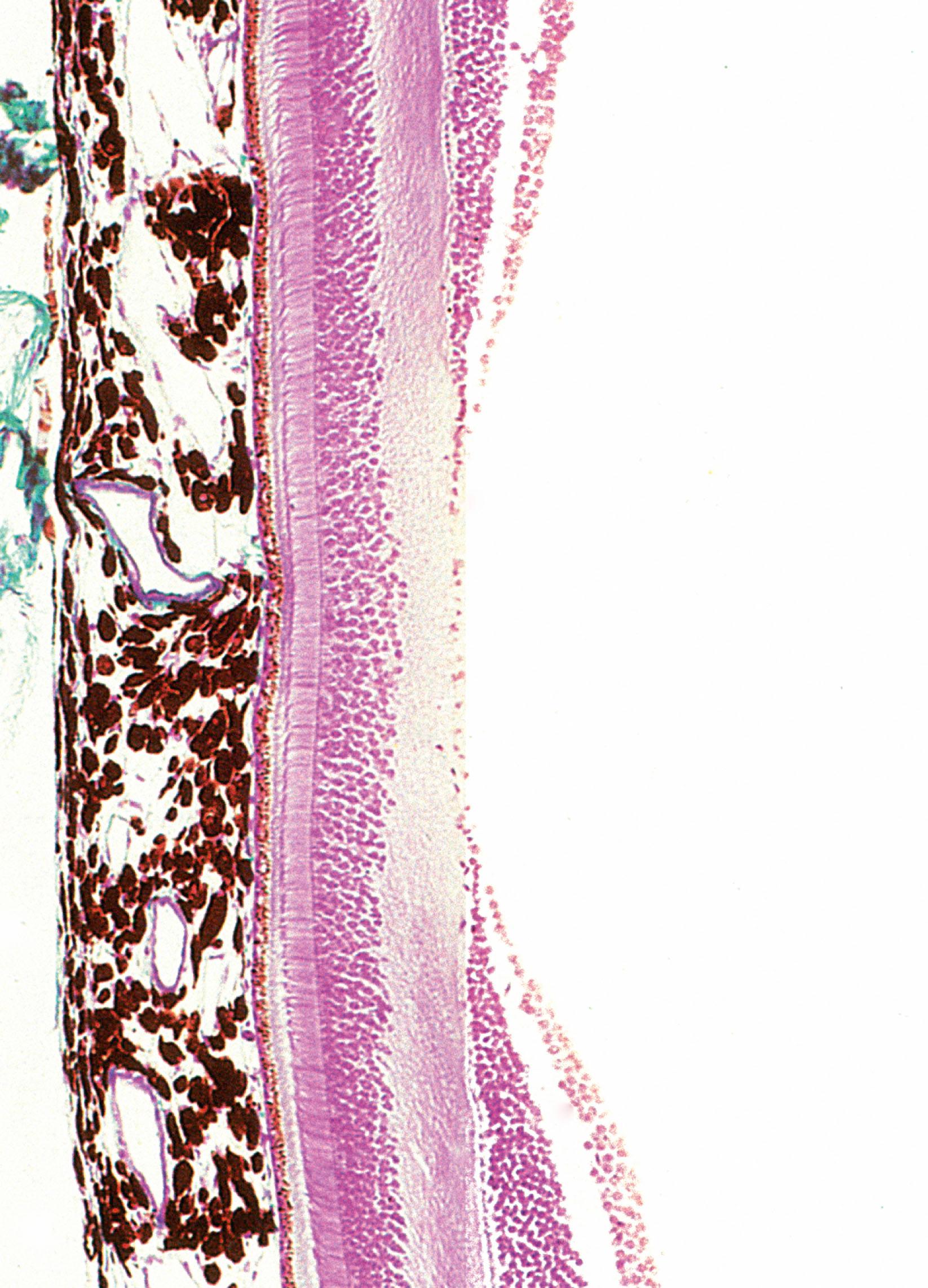
Retinitis pigmentosa is the name given to a family of inherited degenerative diseases of the retina. There are several genetic forms of disease which all cause death of specialised retinal elements. In the commonest forms, there is preferential degeneration of rod cells, leading to gradual loss of peripheral vision, sometimes described as ‘tunnel vision’ as the macula, composed of cones, is affected last.
B Bruch’s membrane M outer limiting membrane P pigment epithelial cell
A central artery of the retina C ciliary process CB ciliary body CS canal of Schlemm D dura mater E epithelium I iris ICA iridocorneal angle L lens M smooth muscle ON optic nerve P pia-arachnoid PC posterior chamber S sclera SL suspensory ligament U uvea
If the drainage of aqueous humor is obstructed and the ciliary body continues to secrete, this may lead to a sustained increase in the intraocular pressure called glaucoma . If untreated this causes damage to the neural retina and can cause blindness.
Some forms of glaucoma are inherited and are associated with abnormal filtration of aqueous humor at the canal of Schlemm.
Any disease which causes inflammation or scarring of the iridocorneal angle can lead to glaucoma by blocking the canal of Schlemm.
Proliferation of blood vessels in the iris root, usually as a response to poor blood supply to the retina, as may happen in patients with diabetes, may block aqueous drainage.
A lens epithelium AC anterior chamber C cornea CA lens capsule CB ciliary body CP constrictor pupillae CPR ciliary process CS canal of Schlemm DP dilator pupillae E lens equator I iris J junction between anterior and posterior lens cells N nuclei of peripheral lens fibres PC posterior chamber R retina T trabeculae
The normal lens is translucent and elastic. If there is damage to the lens fibres or if the normally translucent crystallin proteins aggregate, the lens becomes opaque and light is either diffused or blocked. The lens opacity is called a cataract .
Cataracts can occur due to ageing, trauma to the lens, inflammatory diseases within the eye or in response to some metabolic diseases.
The cornea plays a vital role in refracting light into the eye.
Although the endothelial cell layer looks inconspicuous, it is highly active in pumping fluid out of the corneal stroma. If the endothelial cell layer is damaged or cell numbers are reduced as happens with disease or age, then this fluid pumping function is impaired. Clinically, there is blurring of vision as the corneal stroma becomes waterlogged. The corneal epithelium develops areas of separation from Bowman’s membrane, forming small bullae which are very painful and can lead to ulceration of the surface epithelium.
Diseases which cause inflammation of the cornea (e.g. viral infection by herpes zoster) can lead to loss of Bowman’s membrane and replacement of the normal highly ordered collagen of the corneal stroma by haphazardly arranged collagenous scar tissue. Corneal scars are not transparent and produce an opacity that interferes with light transmission, so causing poor visual acuity.
If the curvature of the cornea becomes abnormal, there may be loss of visual acuity because light is not focused correctly. An unusual condition called keratoconus can develop where the cornea develops a conical profile due to remodeling of the corneal collagen.
A damaged cornea may be replaced by a transplant.
A supporting tissue BM Bowman’s membrane C conjunctiva DM Descemet’s membrane E eyelash En corneal endothelium EP corneal epithelium F hair follicle G Meibomian gland M muscle S skin SP substantia propria of cornea T tarsal plate
The ear or vestibulo-cochlear apparatus has the dual sensory function of maintenance of equilibrium and hearing (stato-acoustic system).
Structurally, the system may be divided into three parts, the external ear , the middle ear and the internal ear . The specific sensory receptors for both movement and sound are situated in a membranous structure located in the internal ear, while the external and middle ear are concerned with reception, transmission and amplification of incoming sound waves.
In this condition, stratified squamous epithelium forms a cyst-like accumulation in the middle ear. It can be congenital, where squamous epithelium remains in the temporal bone during embryogenesis. Secondary causes include repeated infections leading to injury to the tympanic membrane. Cholesteatoma may lead to progressive bony destruction due to ongoing inflammation.
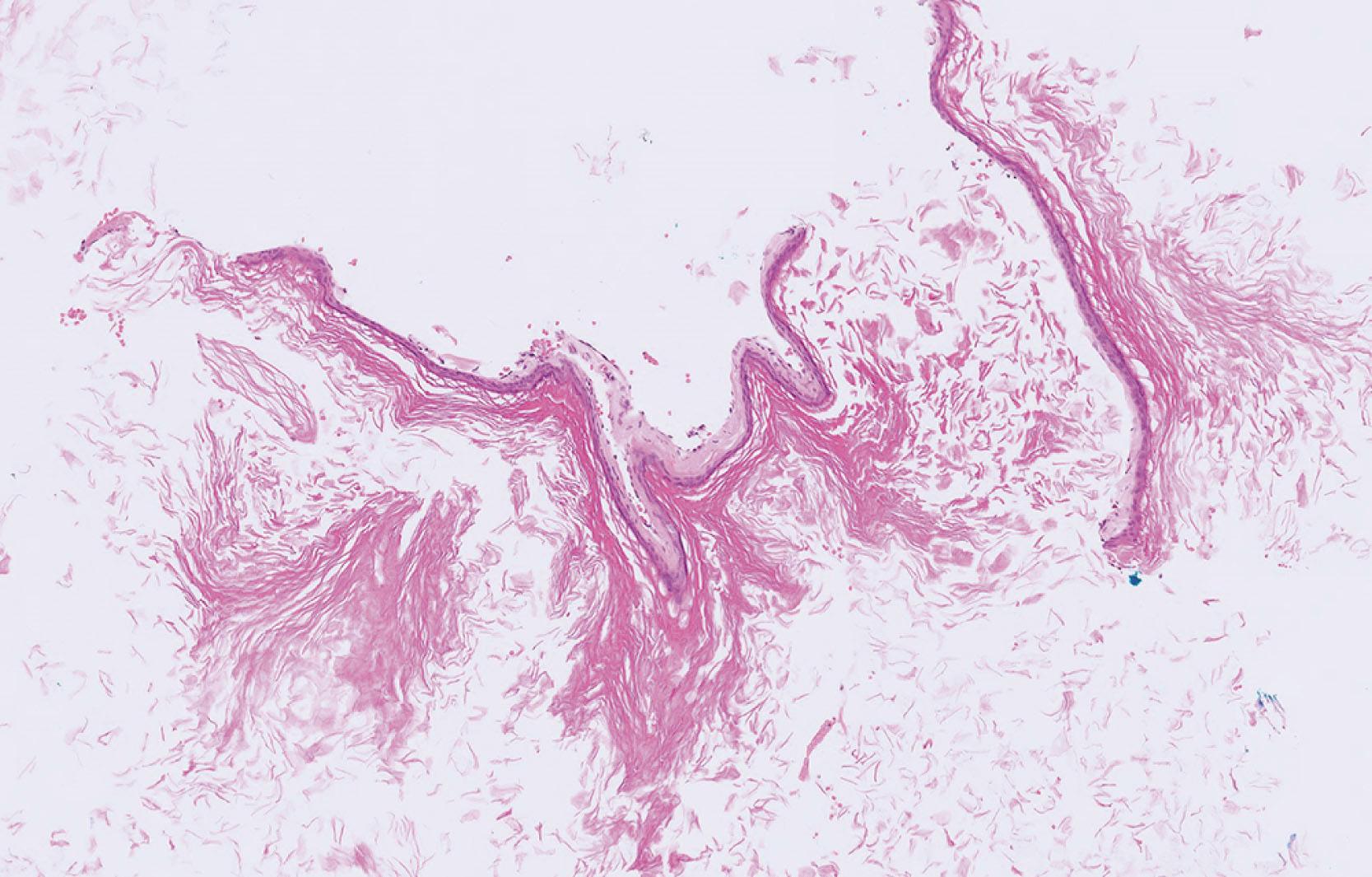
AC auditory canal B temporal bone BS brainstem C cuticular layer Ca cartilage CB compact bone Co cochlea EAM external auditory meatus F hair follicle Fi fibrous layer FN facial nerve G ceruminous gland M mucous layer MAS mastoid air spaces ME middle ear Mu tensor tympani muscle O ossicle S saccule SC semicircular canal SM stapedius muscle TM tympanic membrane U utricle V vestibule VAN vestibulo-auditory nerve
Conductive deafness is caused by disorders that interfere with the conduction of sound through the outer and middle ear, affecting hearing before the sound reaches the cochlea.
Accumulated wax in the external canal is a common cause of impaired hearing.
Inflammation affecting the middle ear can result in secretions building up within the middle ear cavity ( otitis media ) which usually resolves with appropriate therapy.
Otosclerosis is an inherited disease where the ossicles fuse together, preventing conduction of sound. Surgery can re-establish conduction and restore hearing.
Sensorineural deafness is caused by damage to the sensory receptors of the inner ear (hair cells, organ of Corti) or the auditory nerve leading to the brain.
Children may be born with sensorineural deafness due to intrauterine infection or poor oxygen supply near birth. Cochlear implants can restore hearing.
Exposure to noise can cause loss of hearing due to damage to sensory elements in the organ of Corti.
Age-related loss of high-frequency hearing has been called presbycusis .
BM basilar membrane G spiral ganglion O osseous spiral lamina N nerve fibres SL spiral limbus SLig spiral ligament SM scala media ST scala tympani SV scala vestibuli SVasc stria vascularis VM vestibular membrane
O osseous spiral lamina SL spiral limbus SLig spiral ligament SM scala media ST scala tympani T tunnel of Corti TM tectorial membrane
Approximately 50% of childhood deafness is caused by mutations in specific genes. Many of these genes have been found to code for proteins that affect function of the specialised sensory elements found in the inner ear. Approximately 70% of genetic hearing loss cases are nonsyndromic, meaning deafness is the only symptom, and 30% are syndromic, where deafness is part of a larger set of medical symptoms.
Mutations in genes coding for connexin proteins involved in formation of gap junctions (see Fig. 5.12 ) account for a large proportion of cases.
A afferent nerve fibres E efferent nerve fibres G ganglion cells
Ménière’s disease is an abnormality of the inner ear. Clinically, affected patients experience dizziness, disturbance of balance ( vertigo ), a high-pitched rushing or roaring sound in the ears ( tinnitus ) and fluctuating hearing loss.
The symptoms of Ménière’s disease are associated with an increase in endolymph volume within the membranous labyrinth system, which is believed to cause the membranous labyrinth to swell (endolymphatic hydrops), leading to development of abnormal signalling from receptors. The cause of this increase in endolymph remains uncertain. One possibility is rupture of the membranous labyrinth which allows the endolymph to mix with perilymph.
For patients with mild disease, treatment with symptomatic medication can be effective. For patients with debilitating disease, surgical ablation of parts of the labyrinthine system are effective but may involve permanent hearing loss.
Infusion of drugs known to be toxic to the sensory-neural apparatus (e.g. gentamicin) in the middle ear is also used for treatment.
Transient dysfunction of the labyrinthine system can be caused by viral infection (viral labyrinthitis). Patients develop severe dizziness, vertigo, nausea and vomiting which reaches a peak after about 24 hours and subsequently resolves within a week.
C cupula
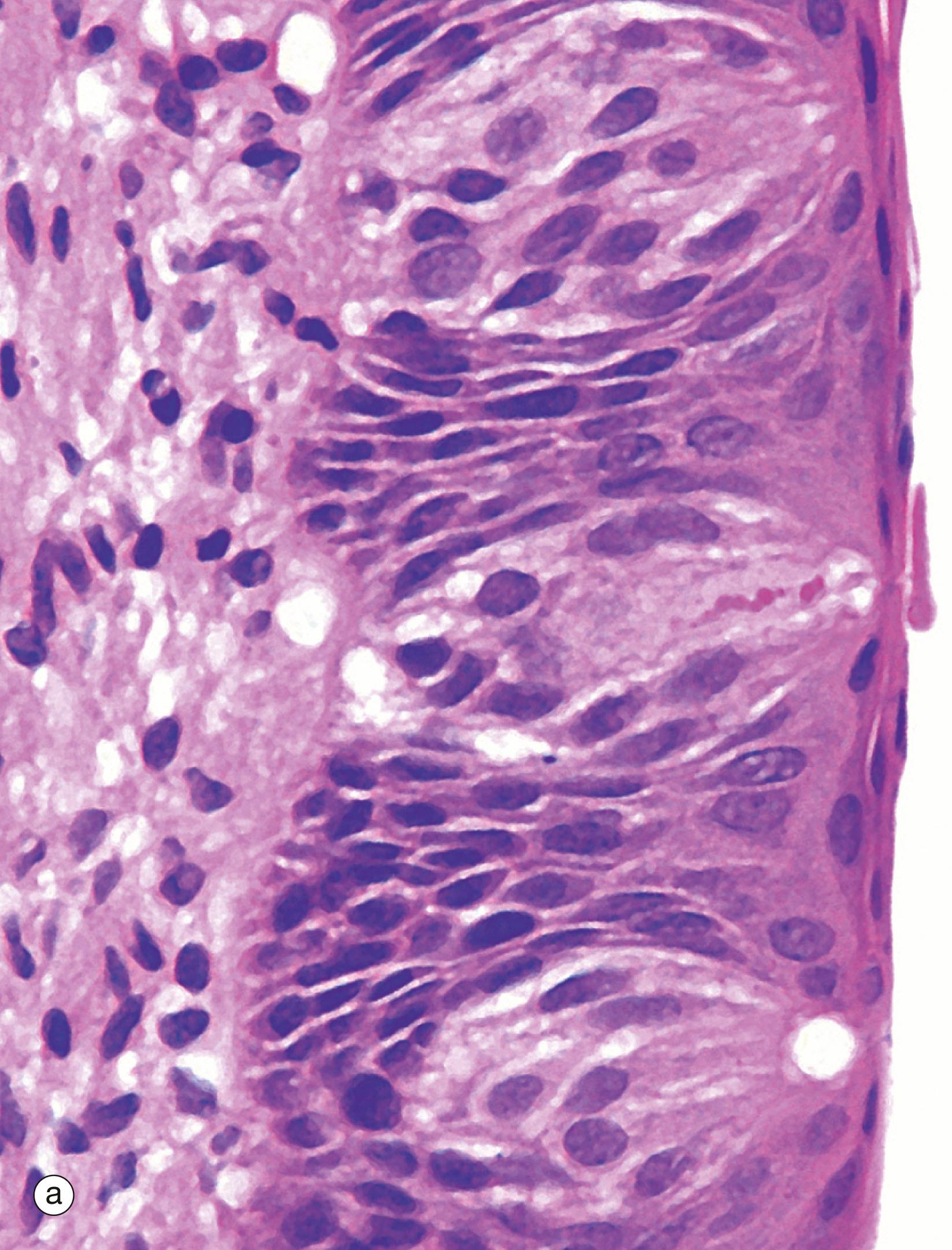
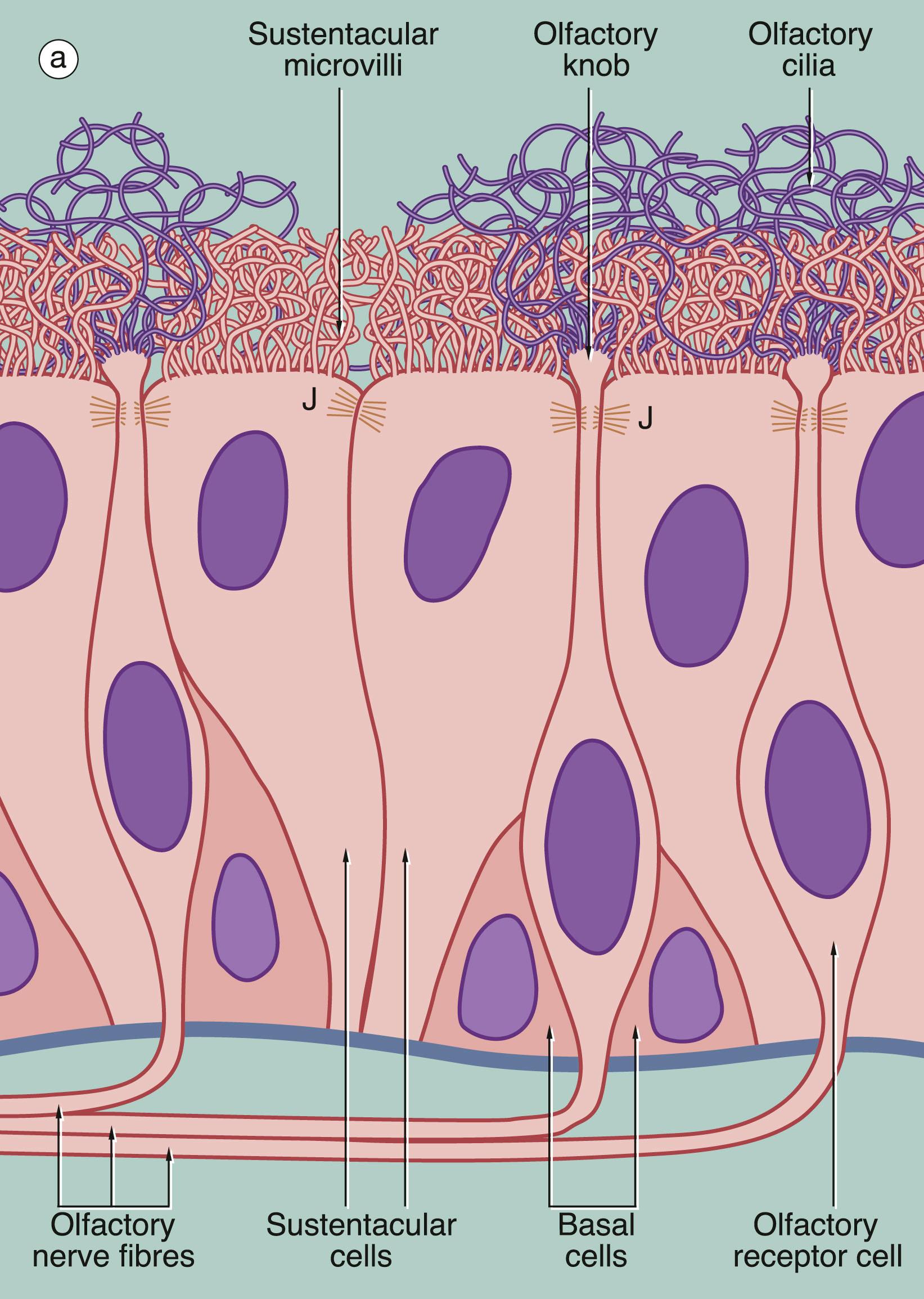
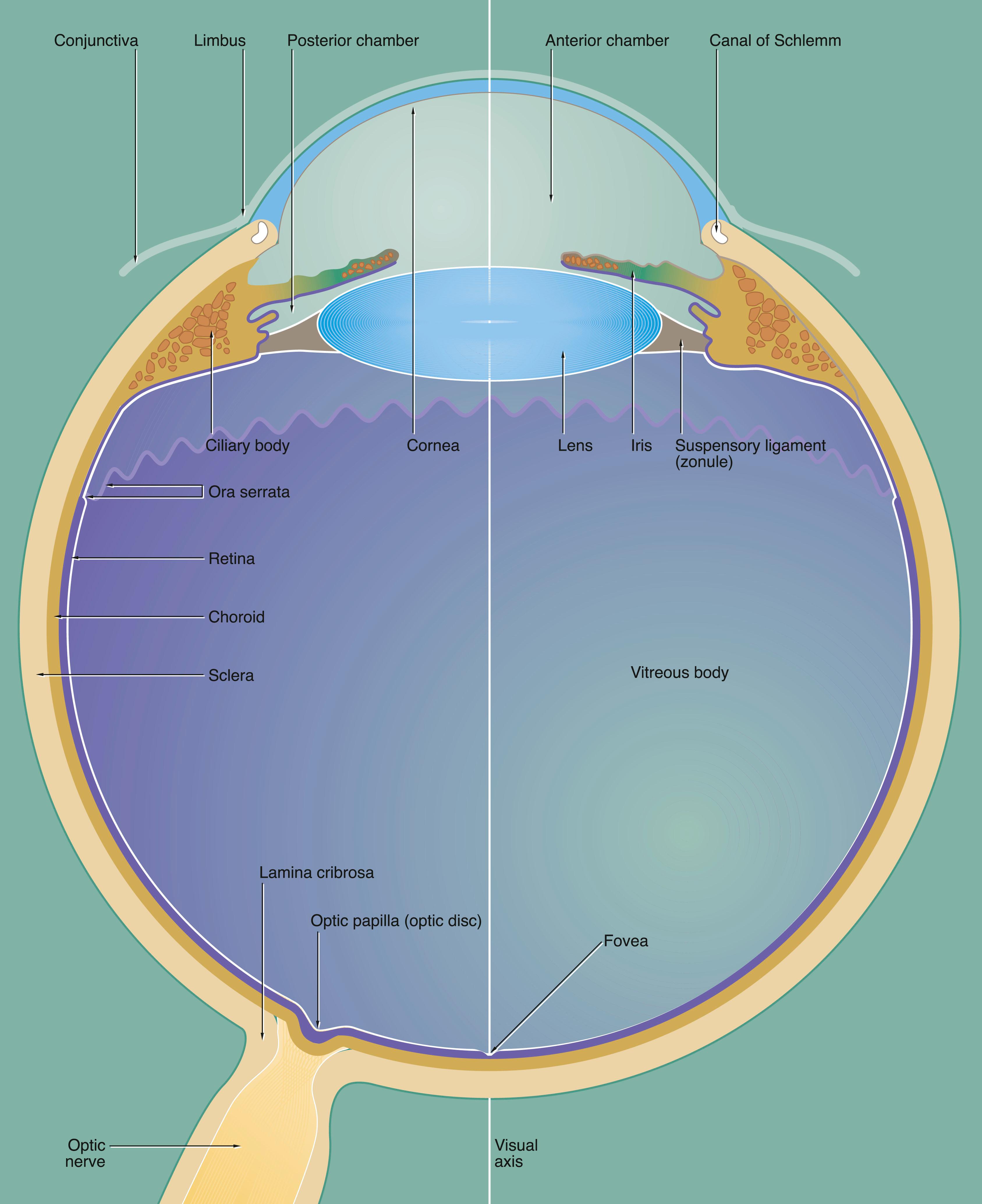
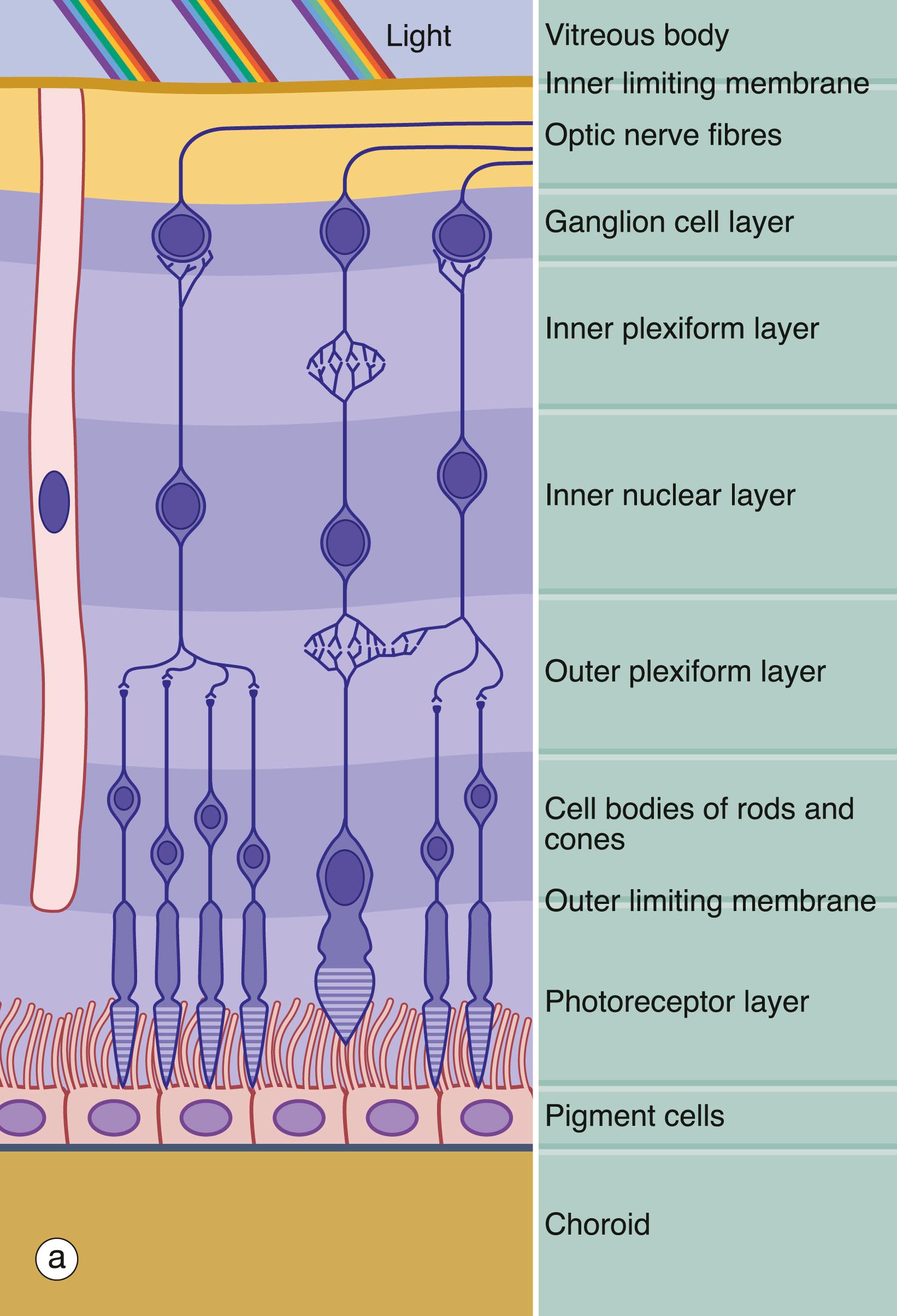
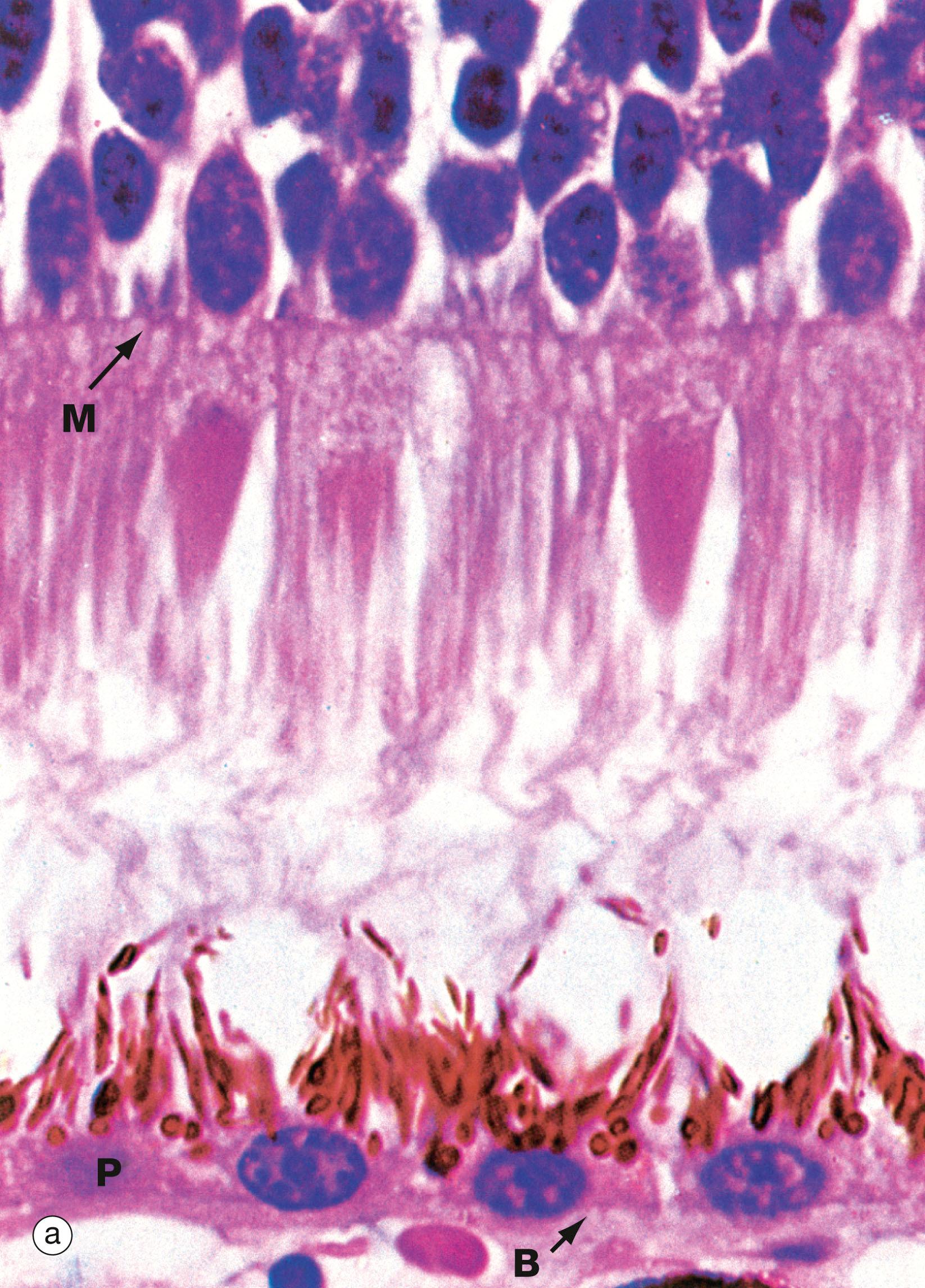
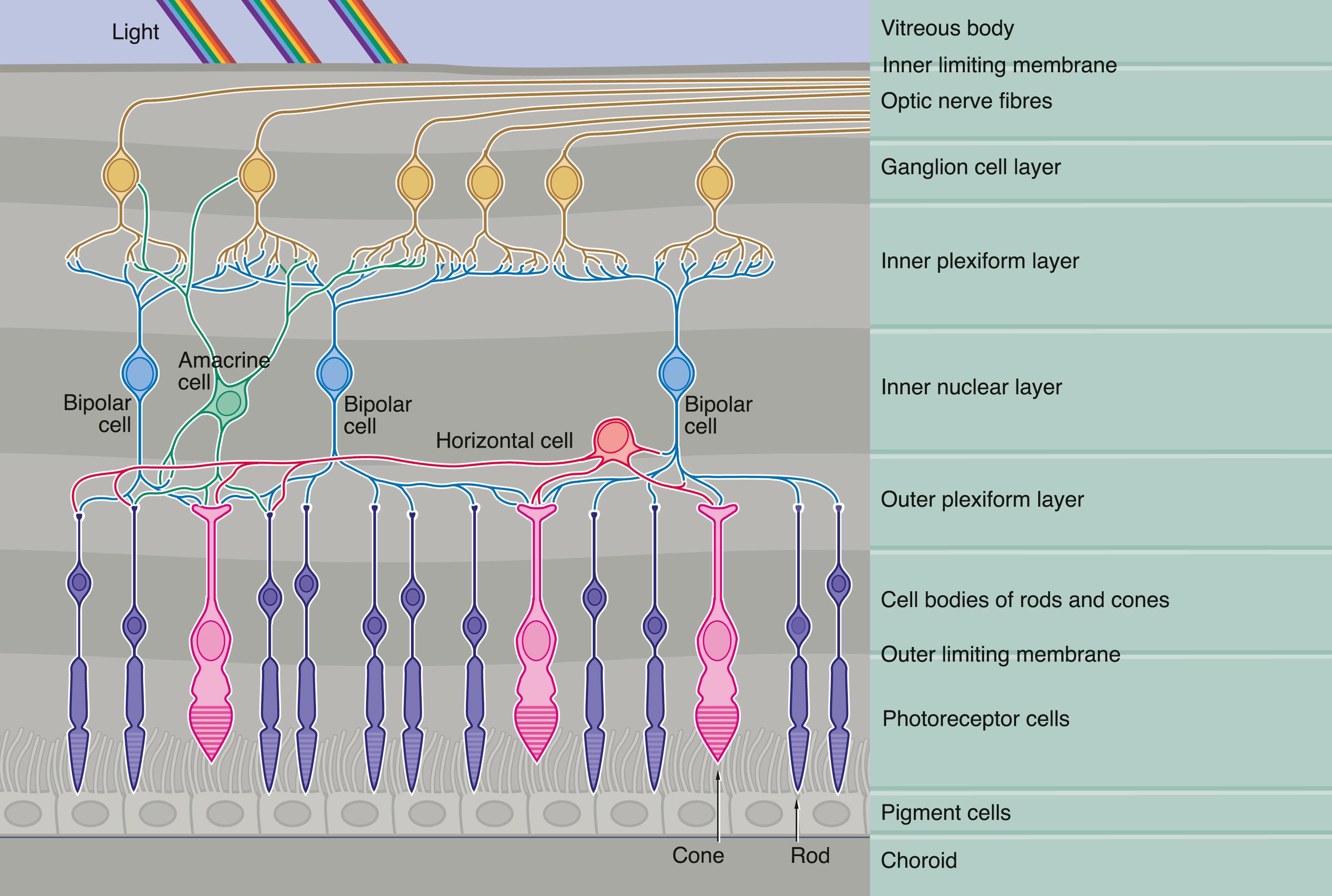

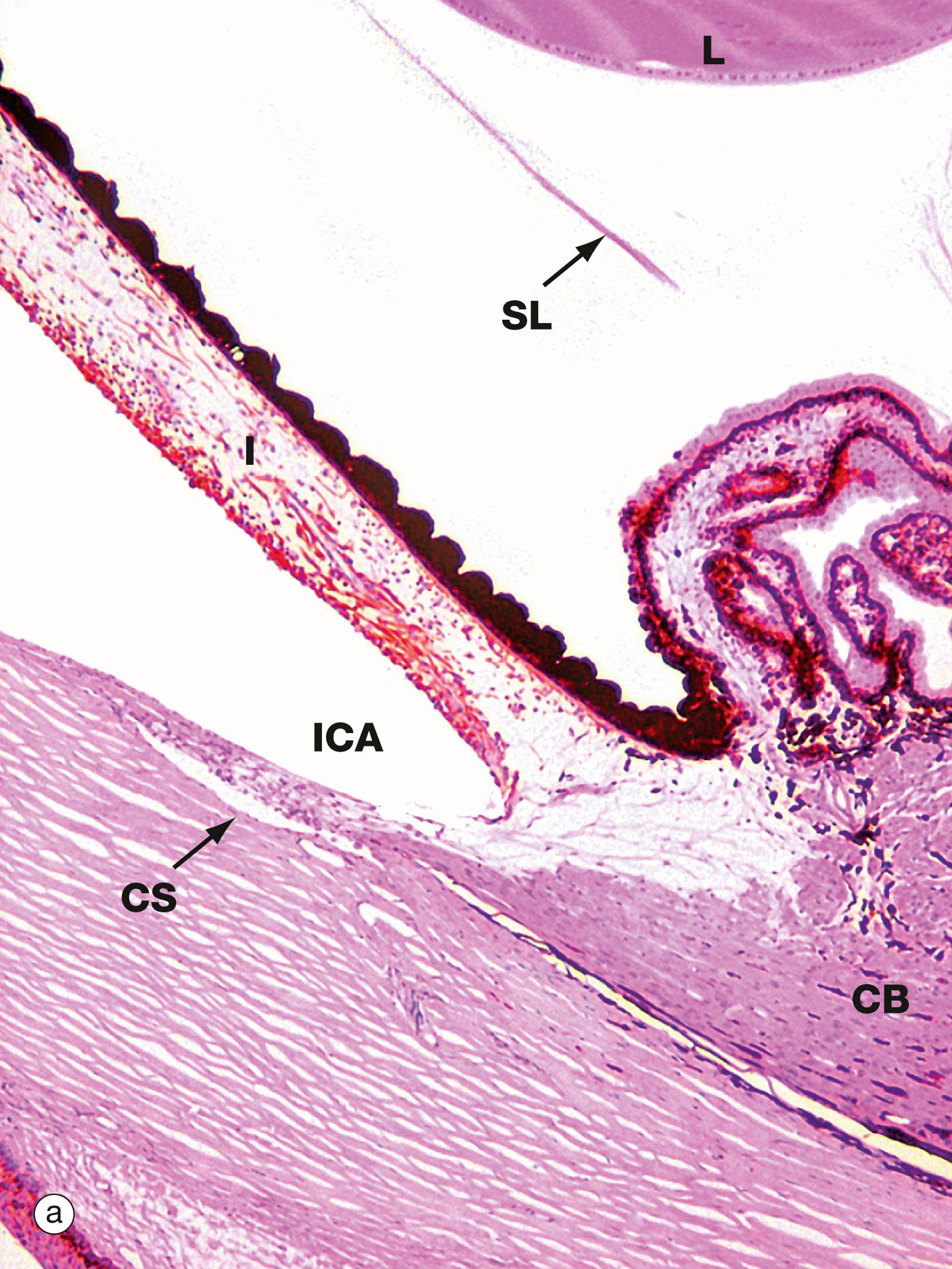
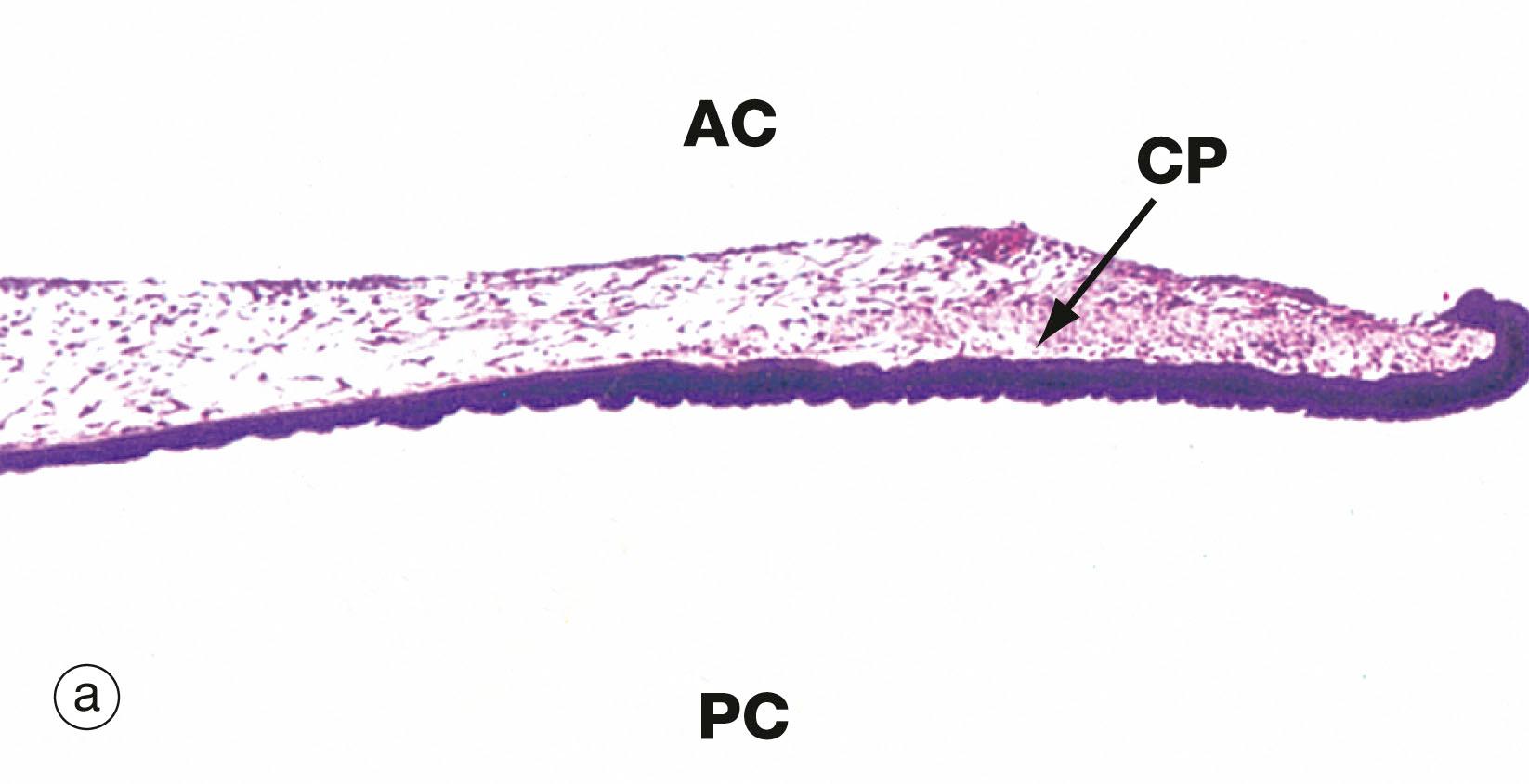
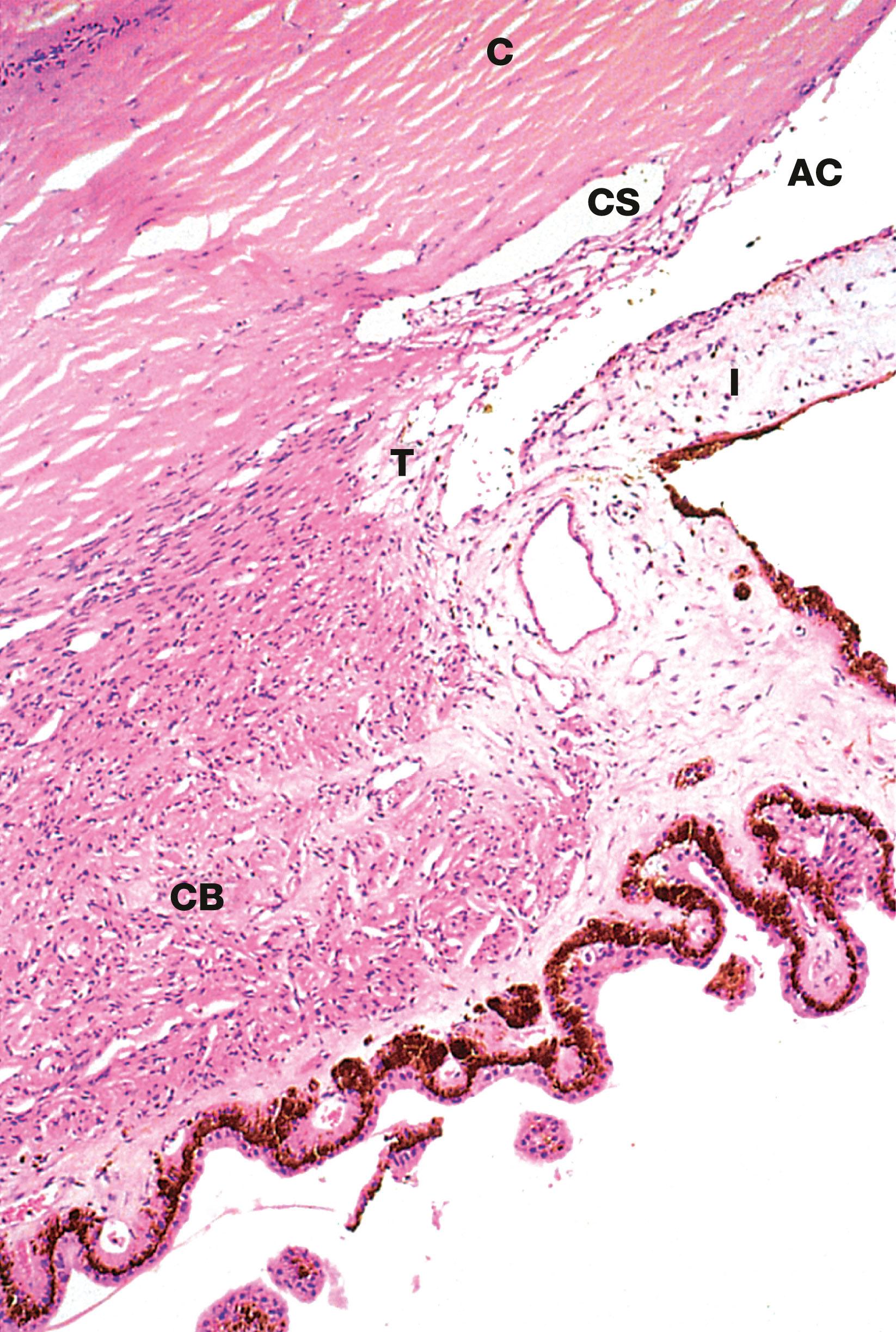
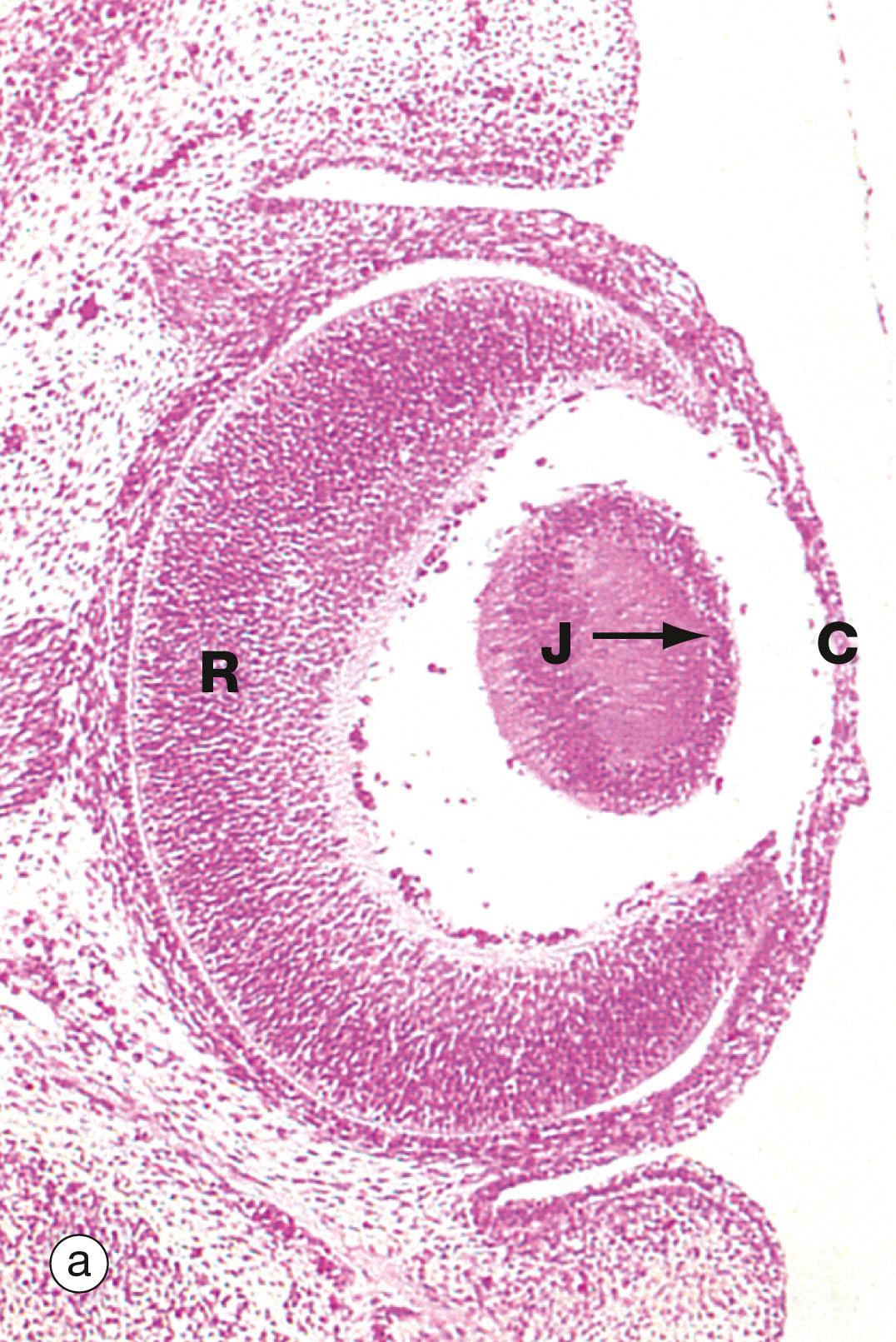
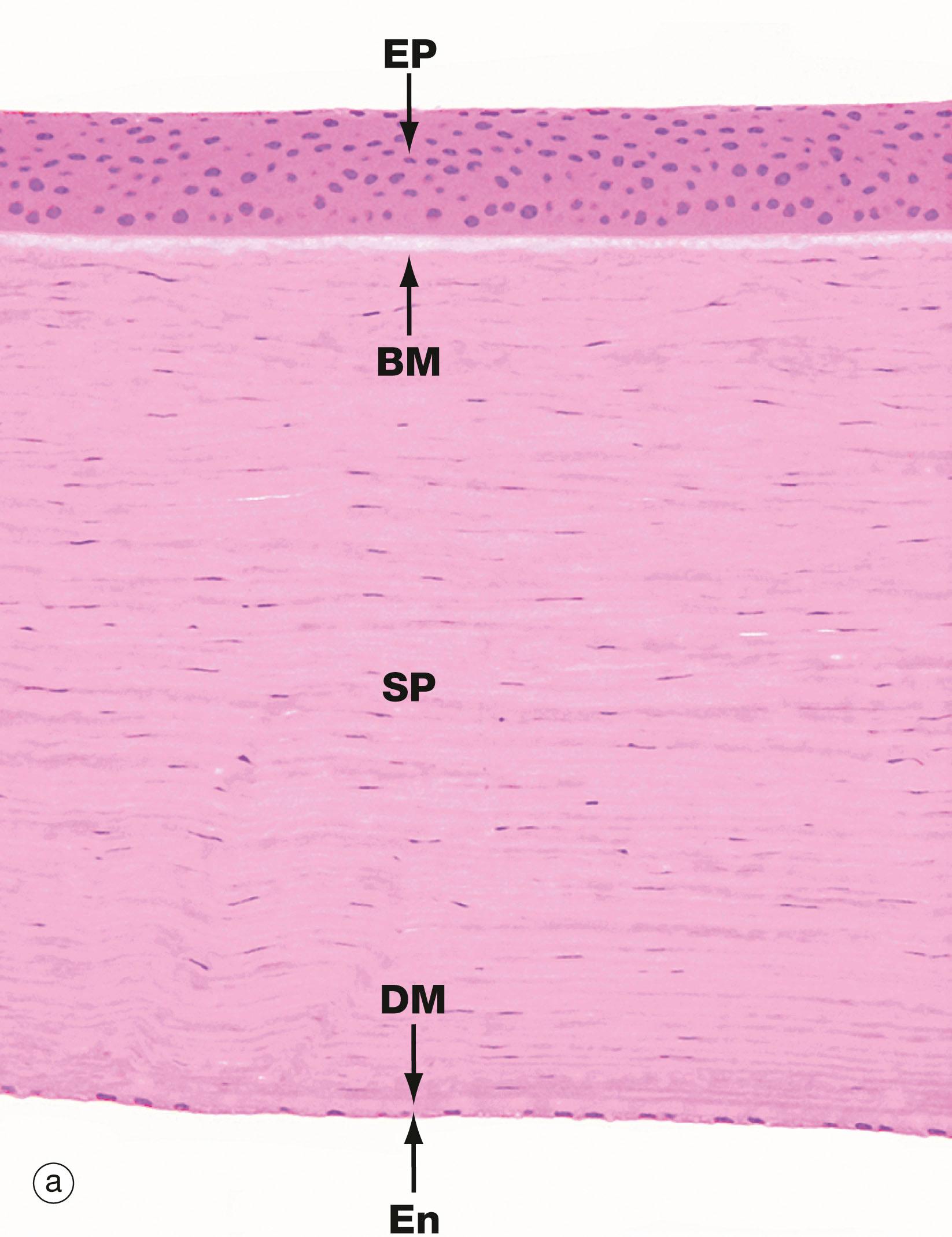
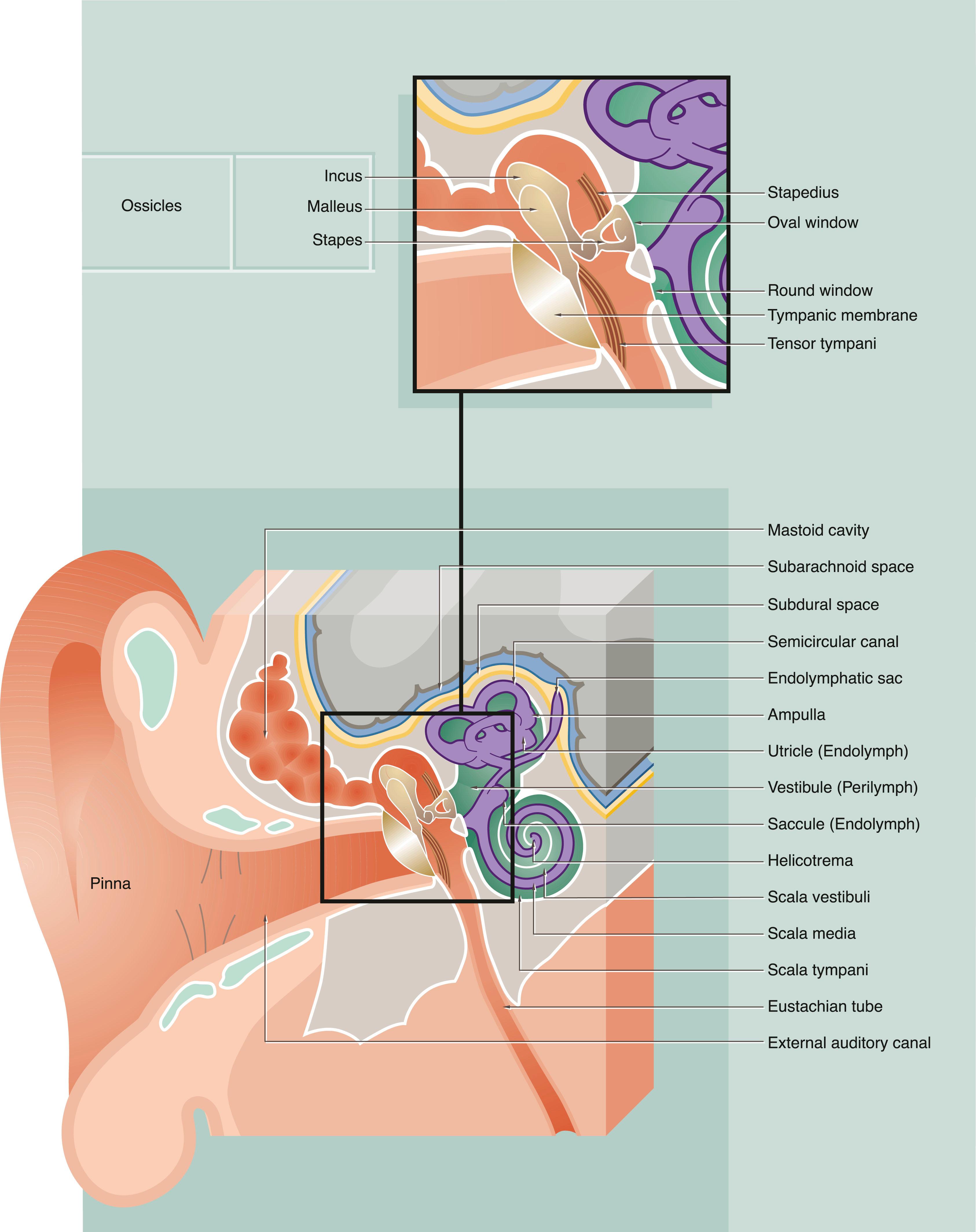
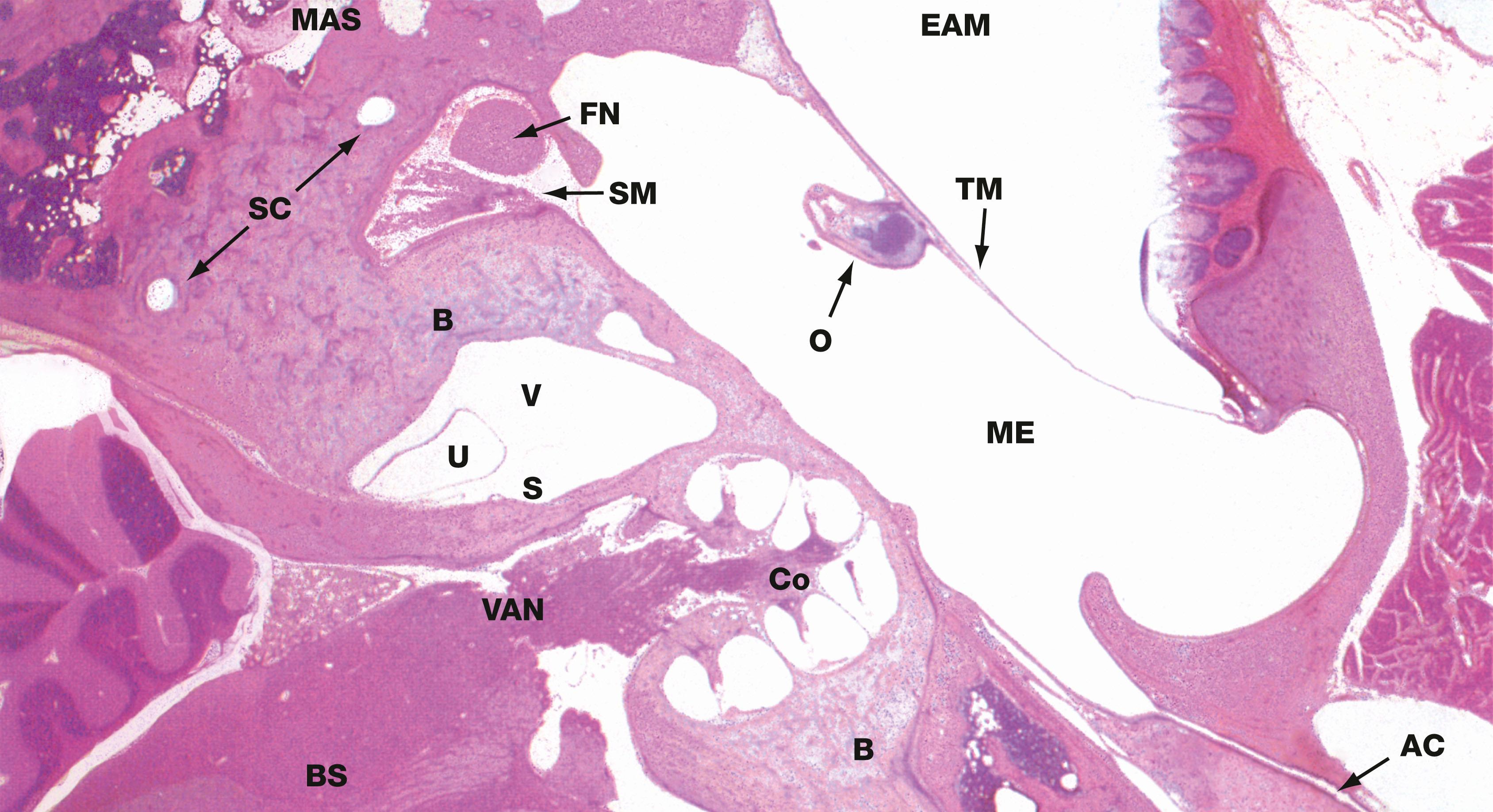
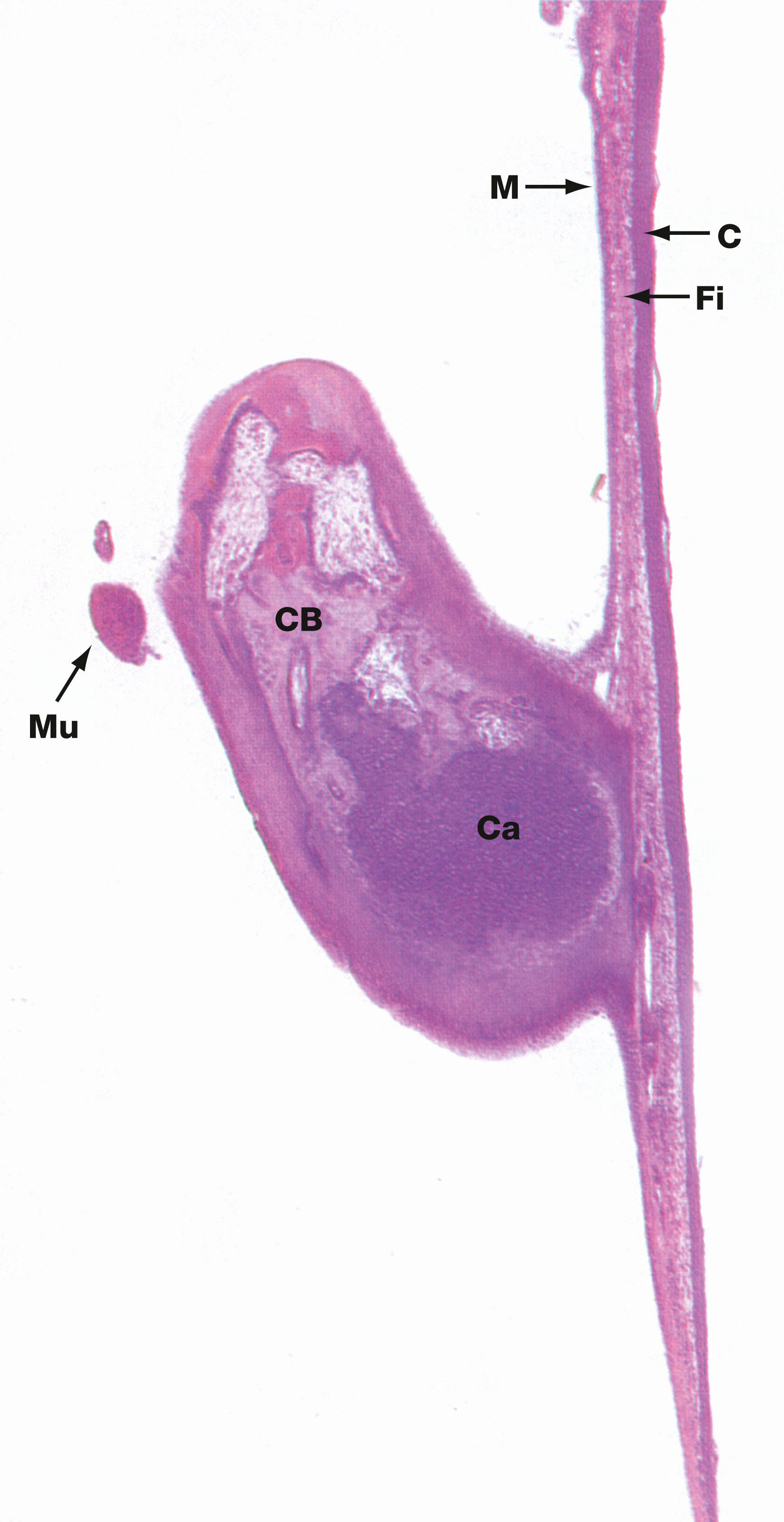
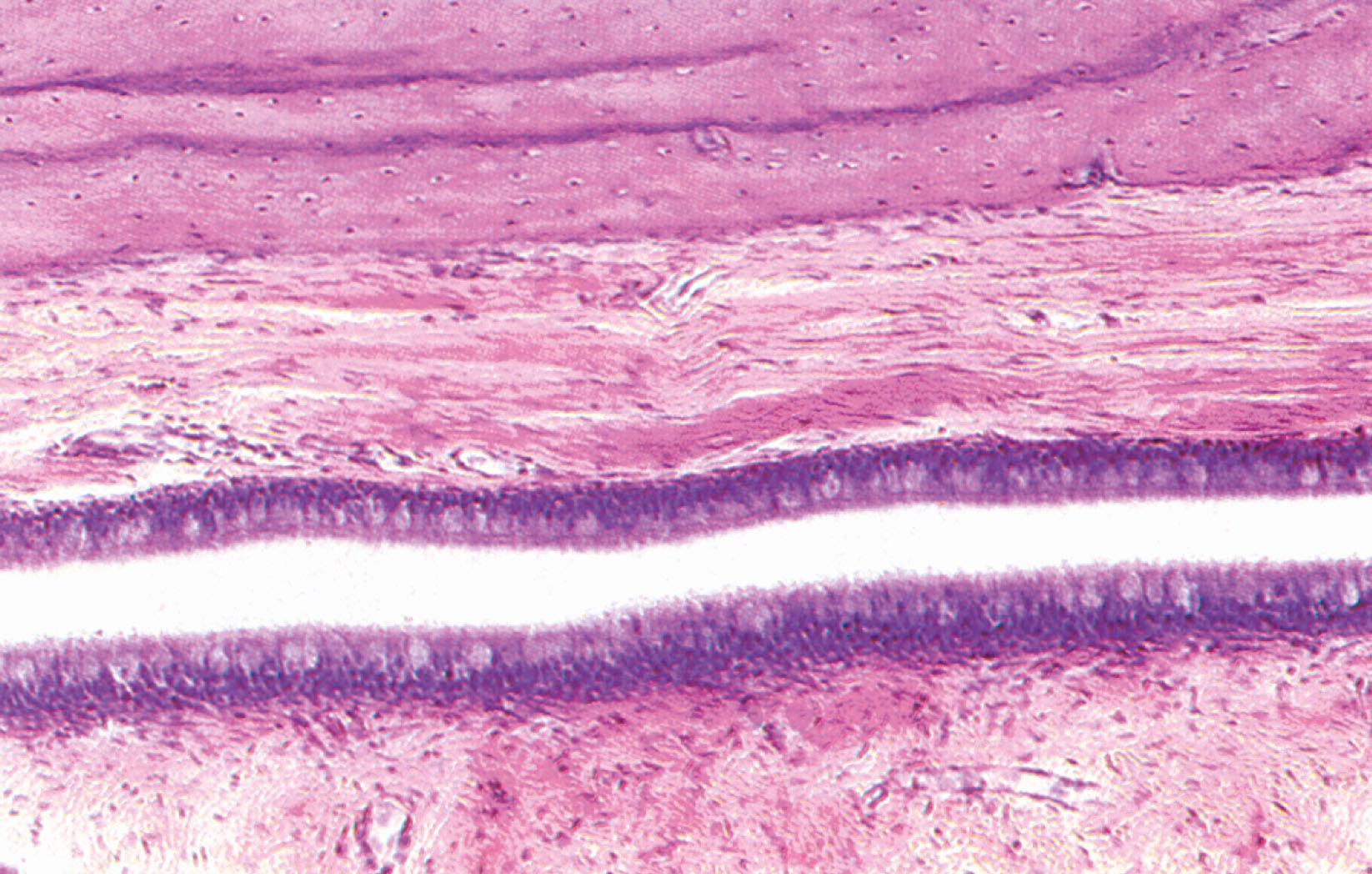
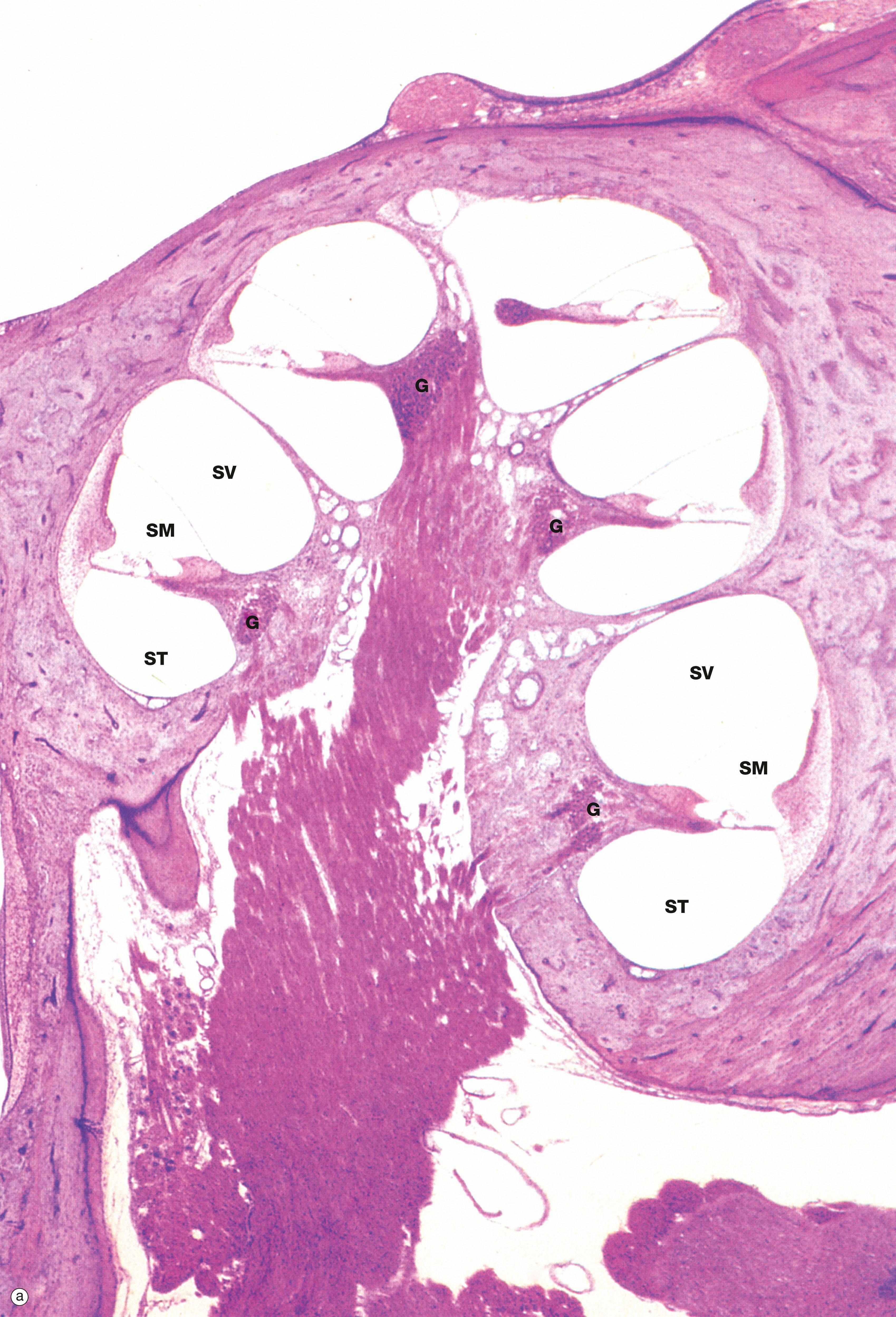
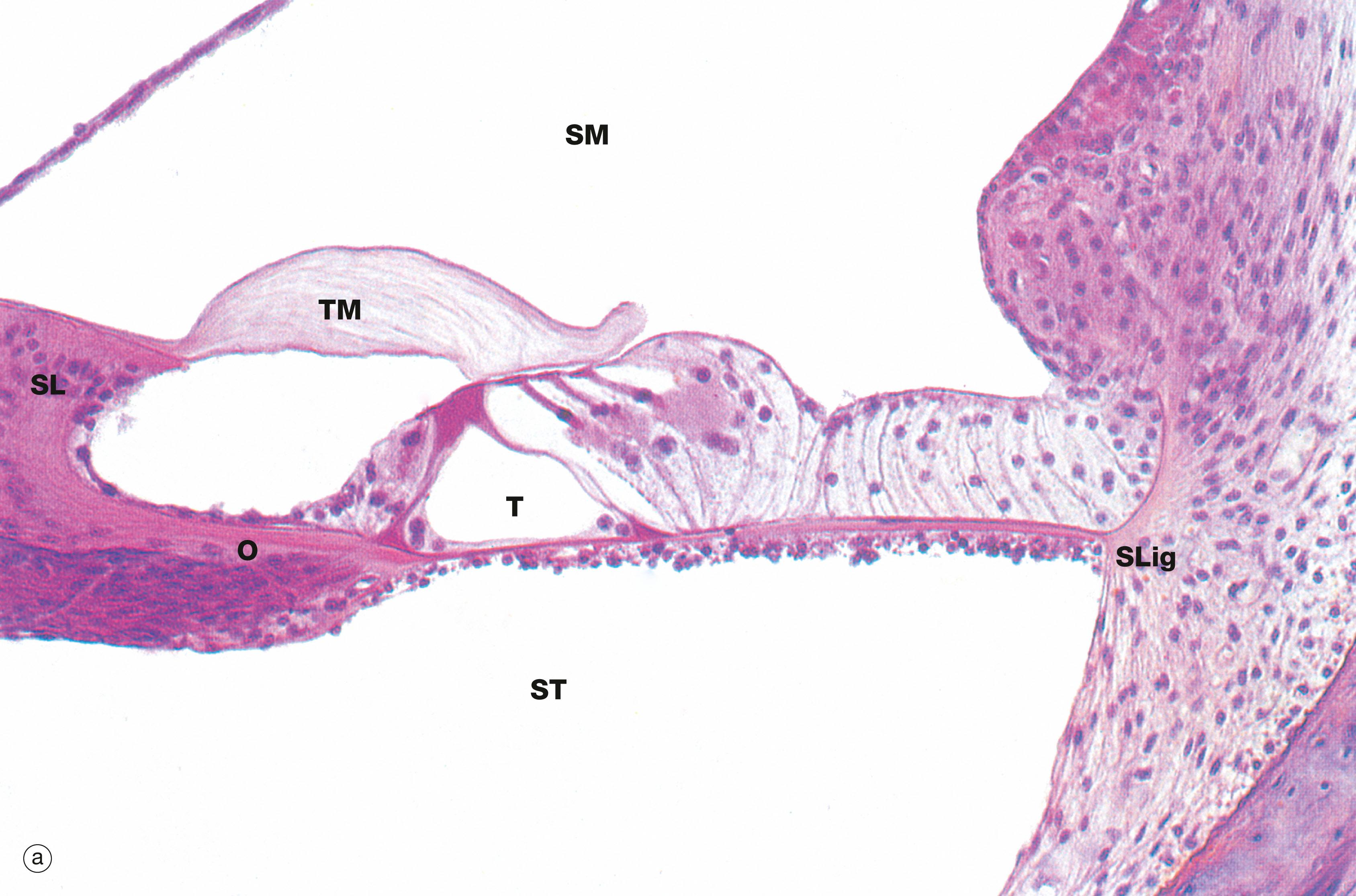
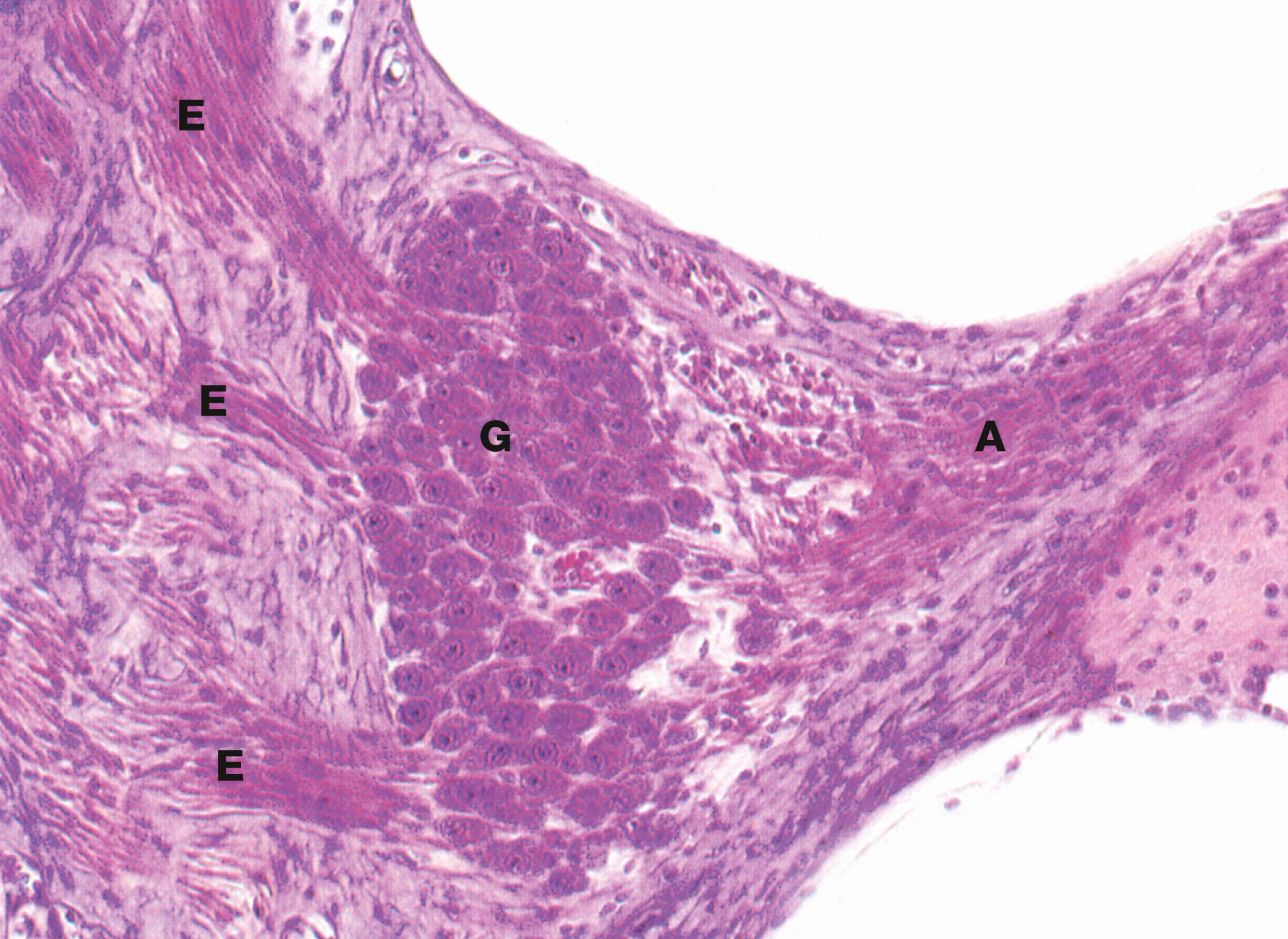
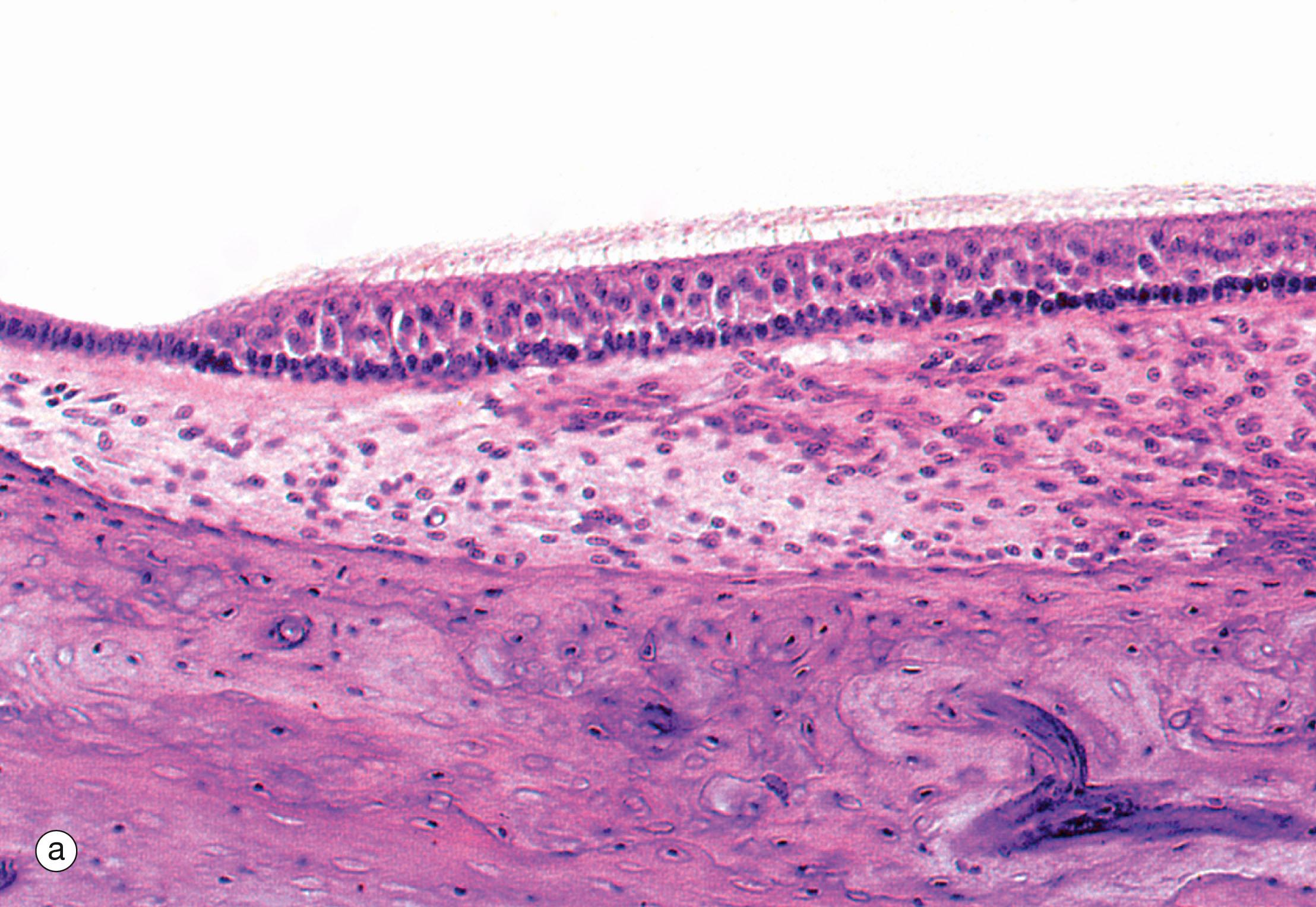
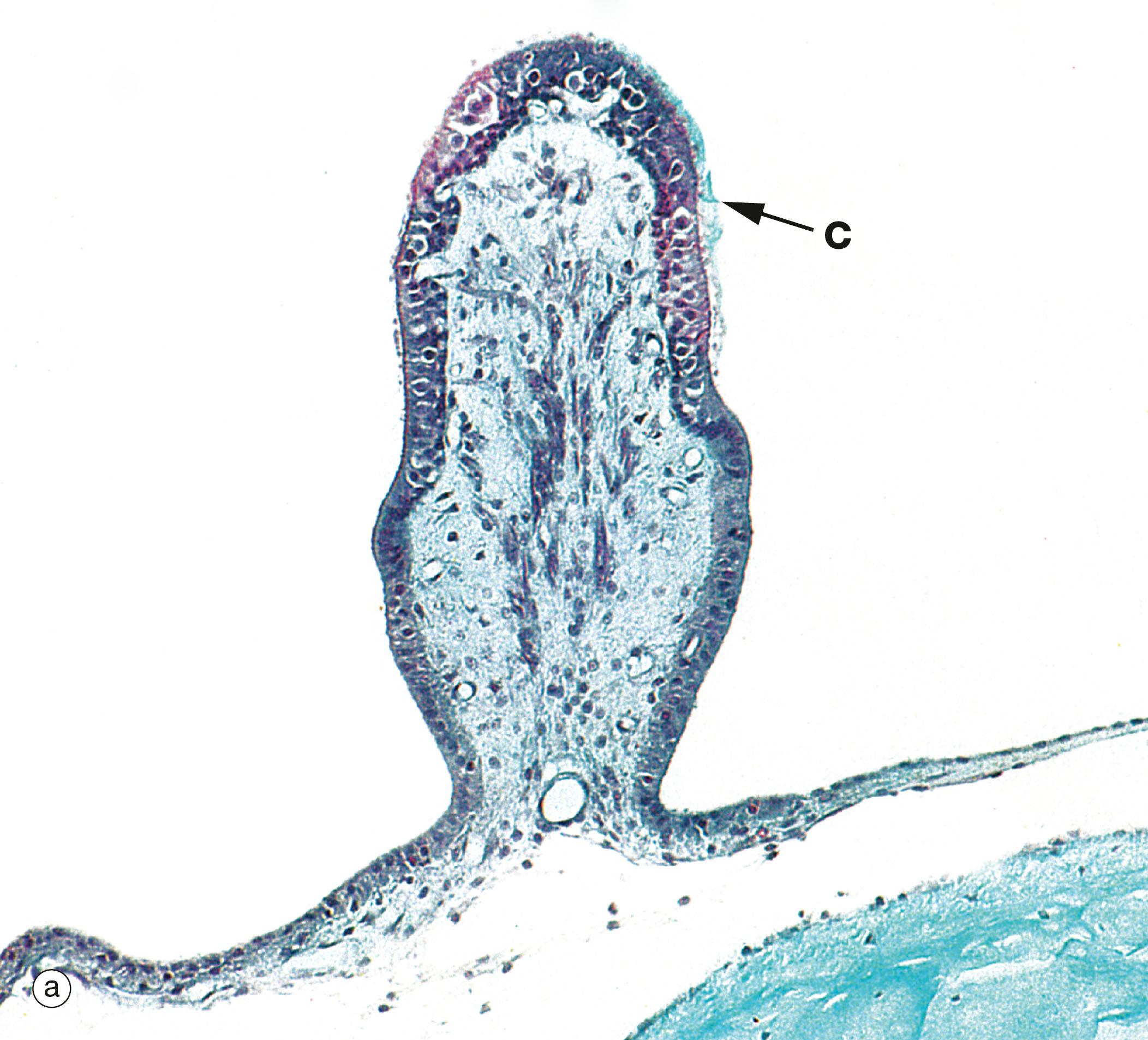
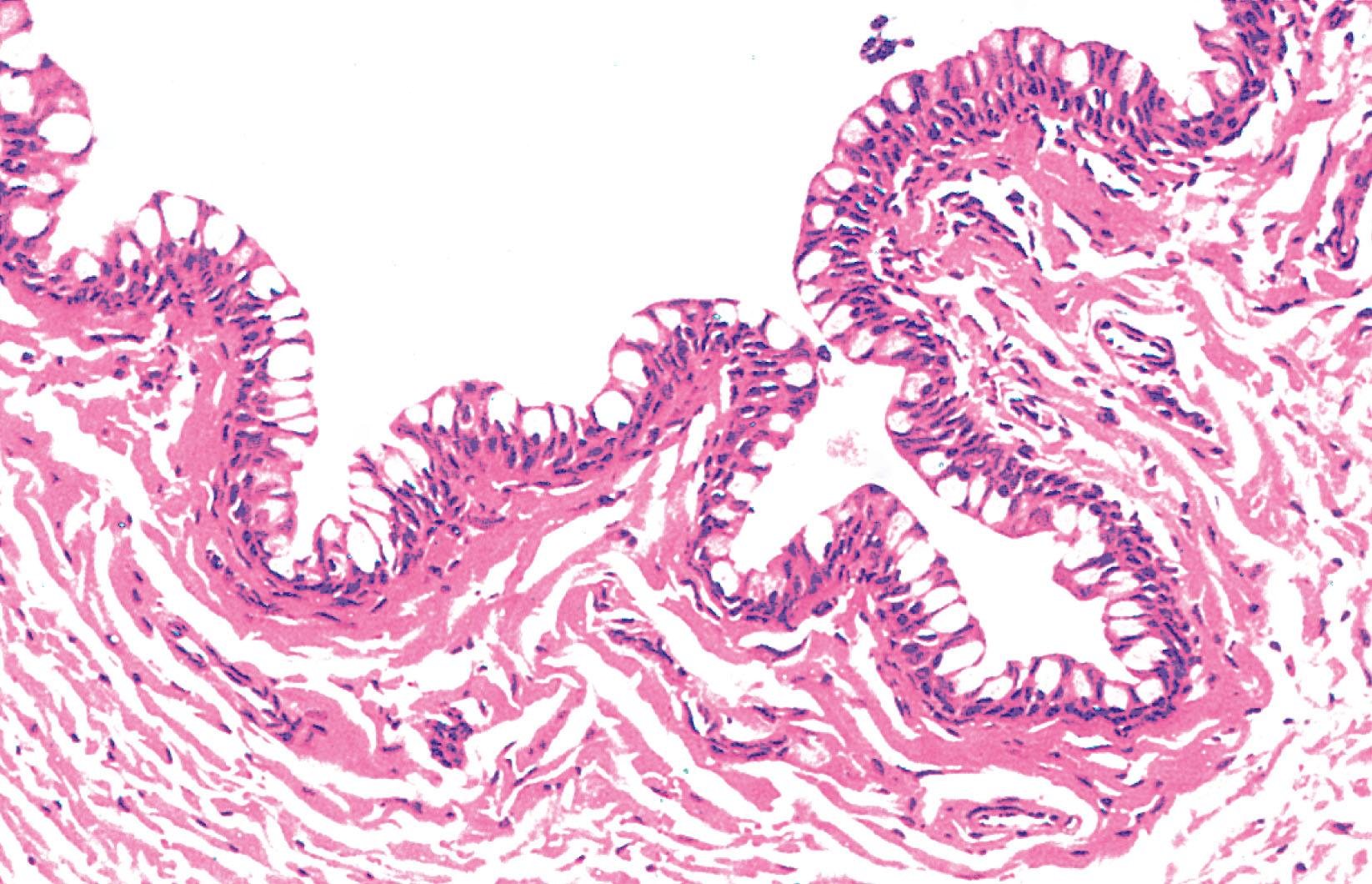
| Major structures | Main components or cells | Brief description/ functional attributes | Figure |
|---|---|---|---|
| Taste buds | Chemoreceptors located in the tongue | Mainly located in the circumvallate papilla Taste – bitter, sweet, salty, sour | 21.1 |
| Olfactory receptors | Olfactory epithelium in roof of nasal cavity formed of chemoreceptor neurones which connect to olfactory bulbs; outgrowths of the brain but called cranial nerve I | Smell | 21.2 |
| Eyes | |||
| Retina | Rods | Light intensity photoreceptors concentrated peripherally | 21.6 , 21.7 |
| Cones | Light colour photoreceptors concentrated centrally | ||
| Fovea | Retinal area in central axis, all colour receptors (cones) | 21.9 | |
| Macula lutea | Retina near to fovea; near-maximum vision; mostly cones, some rods | ||
| Optic disc | Site of exit of optic nerve; no photoreceptors | 21.10 | |
| Cornea | Epithelium | Transparent stratified squamous epithelium which allows light into the eye | 21.15 |
| Stroma | Densely arrayed specialised collagenous fibres and support cells; no blood vessels; transparent | 21.15 | |
| Sclera | Fibrous layer forming the eye globe | Supports the globe; continuous with corneal stroma | 21.4 |
| Uvea | Choroid | Intermediate layer between sclera and retina; contains blood vessels; supplies retina by diffusionDeeply pigmented to prevent light reflection in globe | |
| Ciliary body | Secretes aqueous humor (fluid) into posterior chamber; maintains pressure in globe & globe shapeSupports lens; smooth muscle exerts tension on lens via zonule; varies focal length via tension on lens | 21.11 | |
| Iris | Soft tissue with smooth muscle and pigment, forming variable-sized diaphragm, the pupilSmooth muscle controls diameter of pupil, varying light entry | 21.12 | |
| Canal of Schlemm | Removes fluid from anterior chamber following its circulation from posterior chamber; controls globe pressure | 21.13 | |
| Lens | Elongated cells containing special proteins which lose their nuclei and form a lens | Attached to ciliary body; tension on lens varies focus | 21.14 |
| Ear (hearing) | |||
| External | Pinna and canal | Reception of sound; hair and wax glands protect canal | 21.19 , 21.20 |
| Middle | Middle ear space and Eustachian tube | An air-filled spaceEustachian tube equilibrates air pressure | 21.23 |
| Tympanic membrane | Thin fibrous membrane, separates external and middle earVibrates with sound waves | 21.22 | |
| Ossicles | Chain of bones, malleus, incus and stapes, with synovial joints and muscle. Incus covers oval window.Transfer sound vibrations to oval window, vibrating perilymph | 21.22 | |
| Inner | Labyrinth (three parts: vestibule, semi-circular canals and cochlea) | Endolymph fluid in a membrane-bound space, often surrounded by fluid (perilymph) and located in boneRound window dissipates pressure fluctuations | 21.20 |
| Cochlea | Conical spiral-shaped structure containing organ of CortiConverts perilymph vibration to neural signals (i.e. hearing) | 21.24 | |
| Ear (balance) | |||
| Semi-circular canals | Sensory ridges in canals detect fluid flow caused by head movementsPart of sense of balance for movement | 21.28 | |
| Vestibule | Utricle and saccule are perilymph spaces containing sensory areas, maculae with overlying otoliths.Part of sense of balance/ equilibrium for static position | 21.27 |
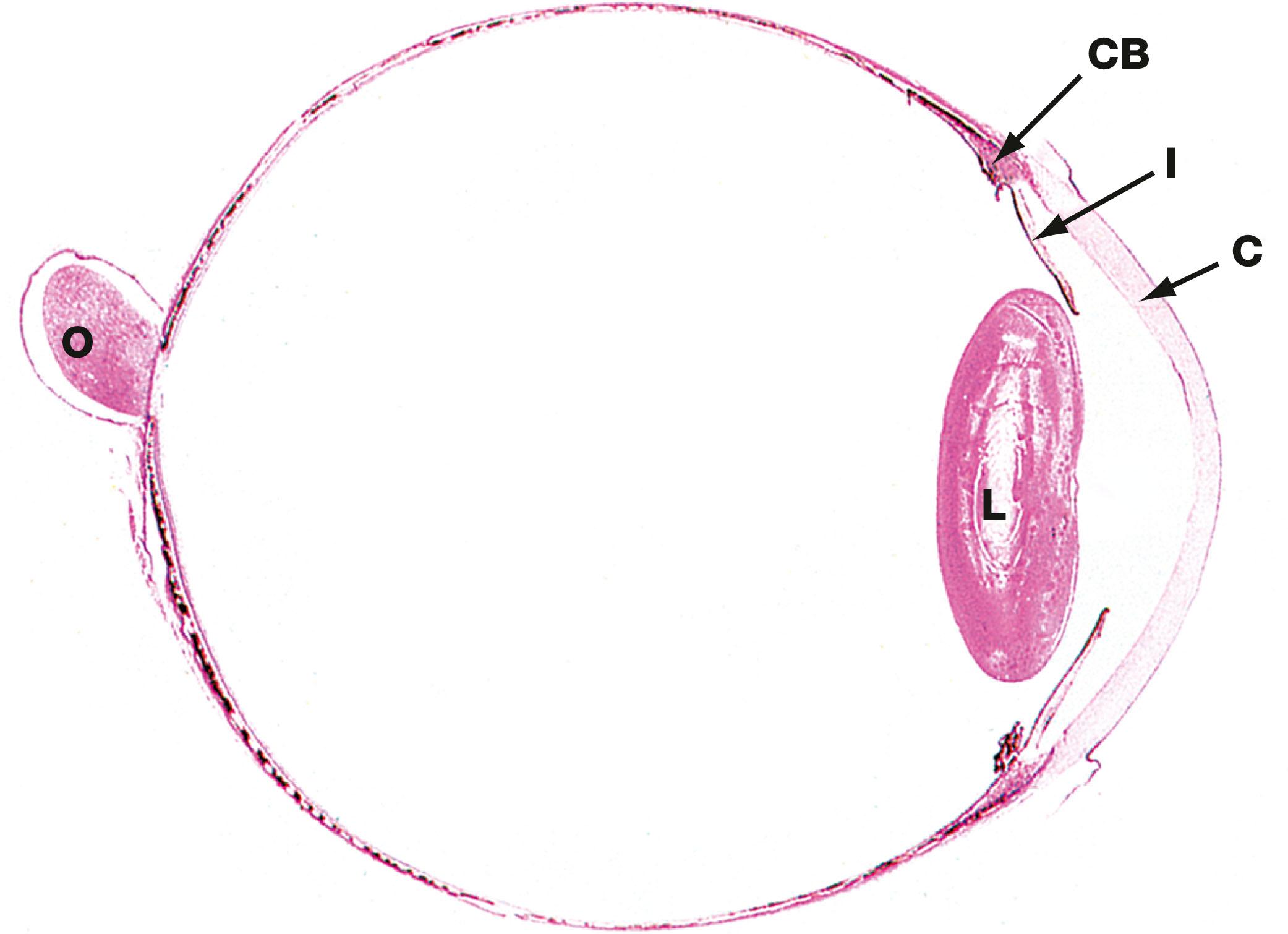

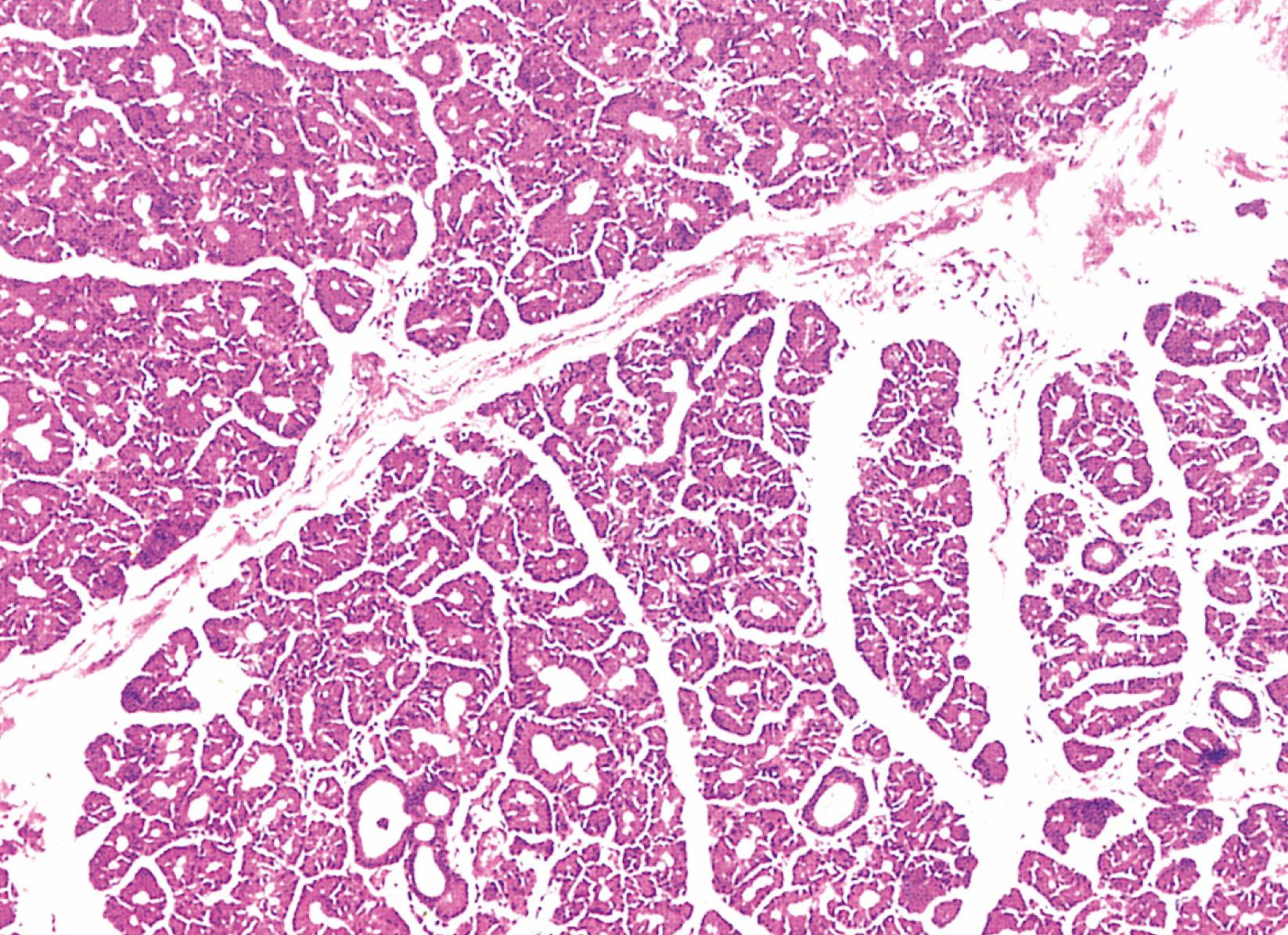
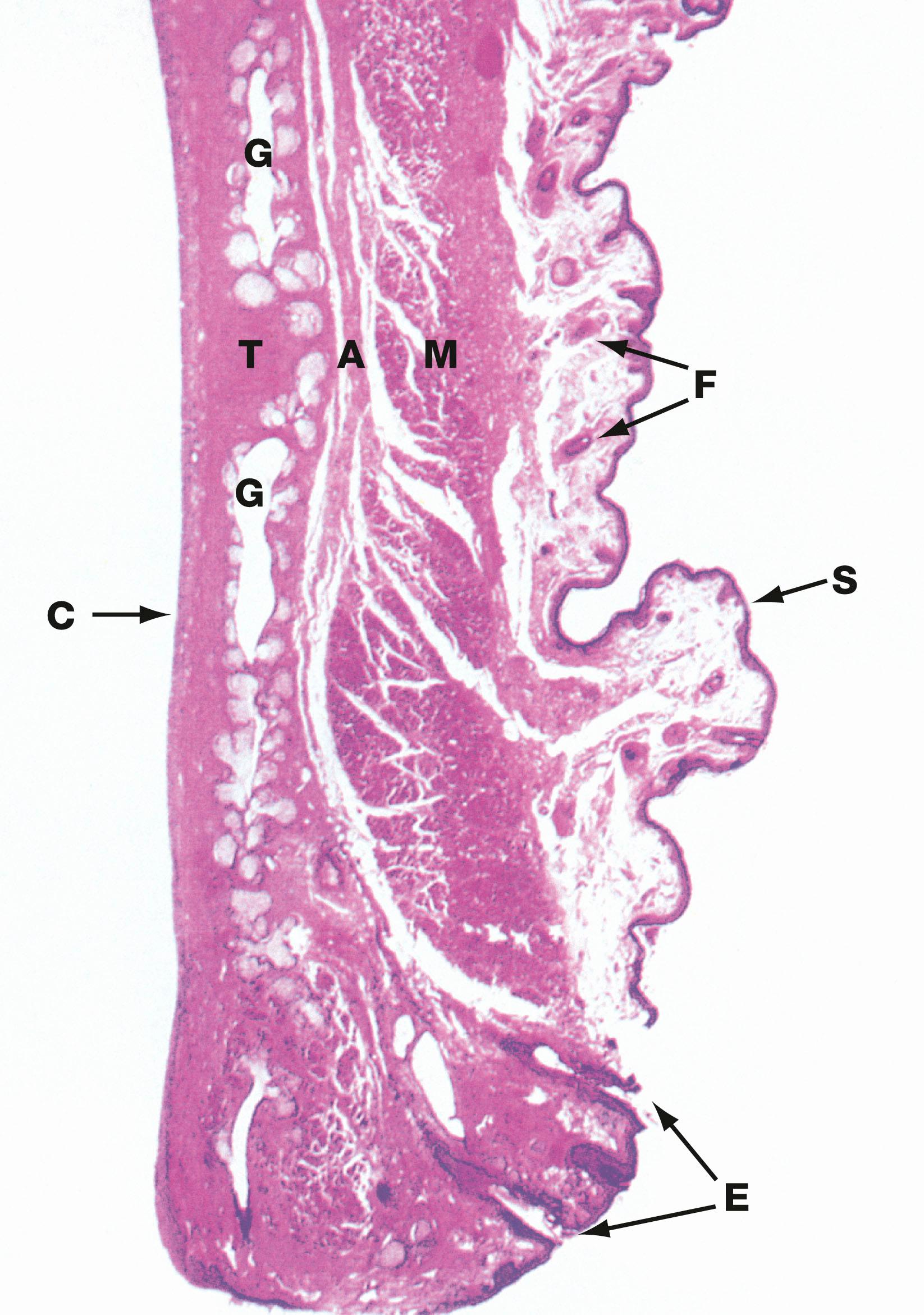
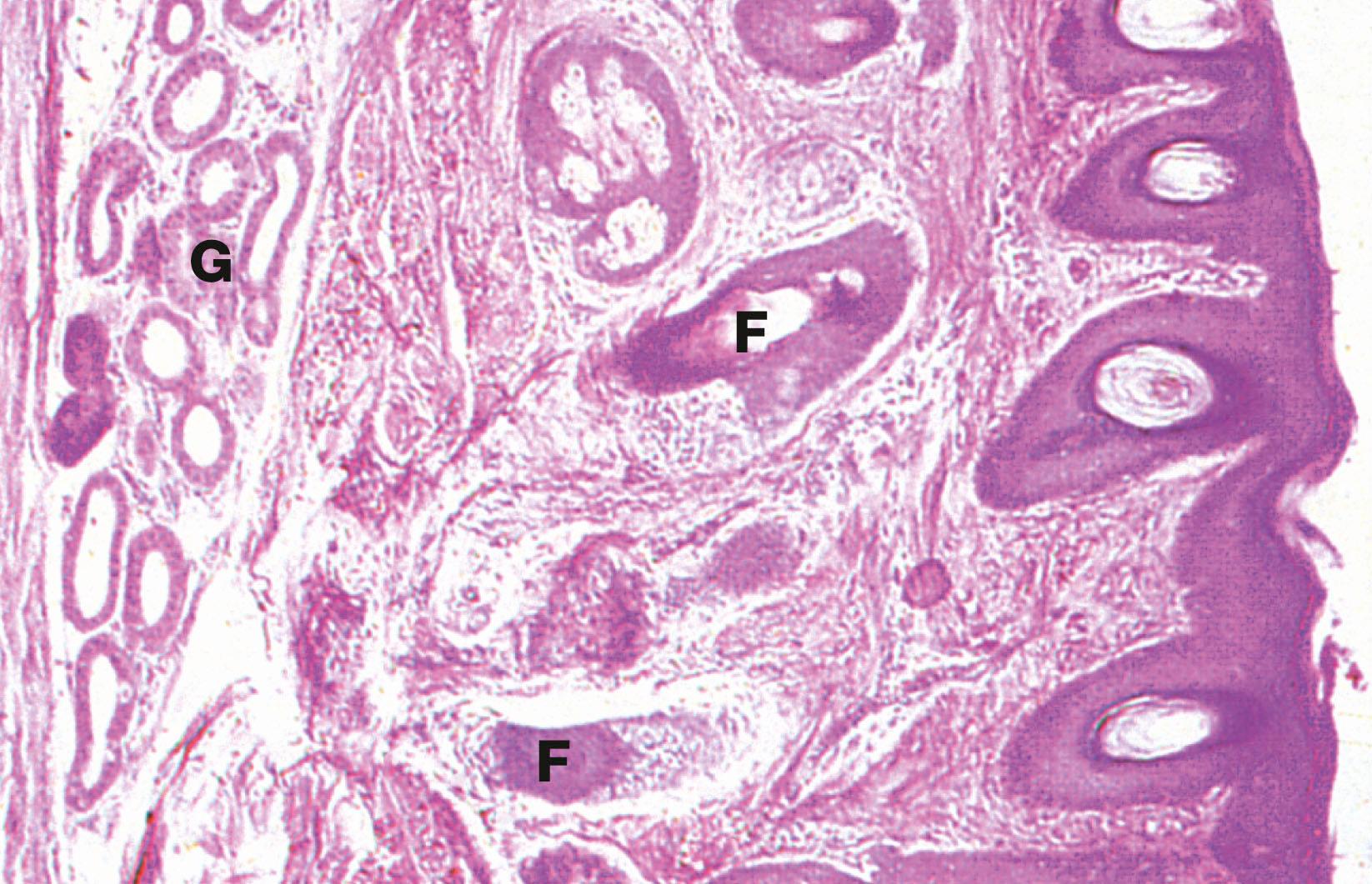
Become a Clinical Tree membership for Full access and enjoy Unlimited articles
If you are a member. Log in here